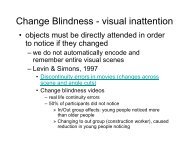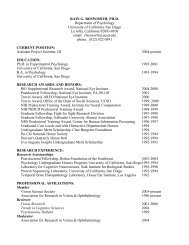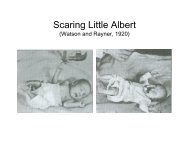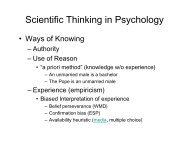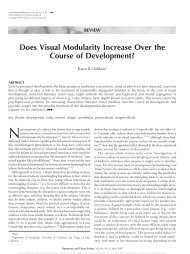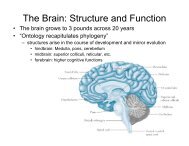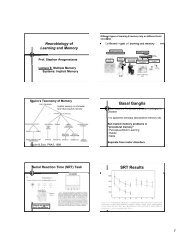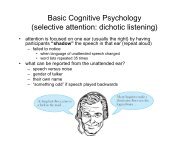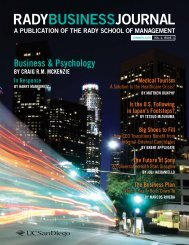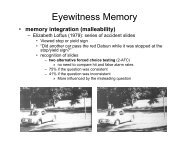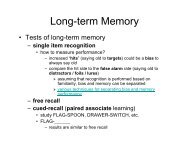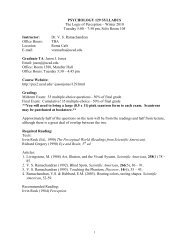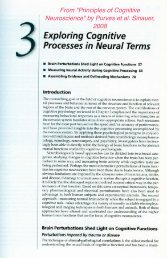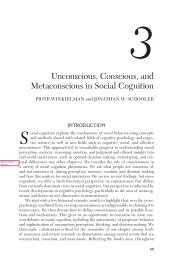''I saw it with my own ears'': The effects of peer conversations on ...
''I saw it with my own ears'': The effects of peer conversations on ...
''I saw it with my own ears'': The effects of peer conversations on ...
You also want an ePaper? Increase the reach of your titles
YUMPU automatically turns print PDFs into web optimized ePapers that Google loves.
‘‘I <str<strong>on</strong>g>saw</str<strong>on</strong>g> <str<strong>on</strong>g>it</str<strong>on</strong>g> w<str<strong>on</strong>g>it</str<strong>on</strong>g>h <str<strong>on</strong>g>my</str<strong>on</strong>g> <str<strong>on</strong>g>own</str<strong>on</strong>g> ears’’: <str<strong>on</strong>g>The</str<strong>on</strong>g> <str<strong>on</strong>g>effects</str<strong>on</strong>g> <str<strong>on</strong>g>of</str<strong>on</strong>g><br />
<str<strong>on</strong>g>peer</str<strong>on</strong>g> <str<strong>on</strong>g>c<strong>on</strong>versati<strong>on</strong>s</str<strong>on</strong>g> <strong>on</strong> preschoolersÕ<br />
reports <str<strong>on</strong>g>of</str<strong>on</strong>g> n<strong>on</strong>experienced events<br />
Abstract<br />
J. Experimental Child Psychology 83 (2002) 1–25<br />
Gabrielle F. Principe * and Stephen J. Ceci<br />
Department <str<strong>on</strong>g>of</str<strong>on</strong>g> Human Development, Cornell Univers<str<strong>on</strong>g>it</str<strong>on</strong>g>y<br />
Received 24 April 2002; revised 21 August 2002<br />
www.academicpress.com<br />
<str<strong>on</strong>g>The</str<strong>on</strong>g> study was designed to explore the <str<strong>on</strong>g>effects</str<strong>on</strong>g> <str<strong>on</strong>g>of</str<strong>on</strong>g> naturally occurring <str<strong>on</strong>g>peer</str<strong>on</strong>g> interacti<strong>on</strong>s<br />
and repeated suggestive interviews <strong>on</strong> preschoolersÕ (N ¼ 96, Mean age ¼ 54<br />
m<strong>on</strong>ths) memories for a pers<strong>on</strong>ally experienced event, namely a staged archaeological<br />
dig. During the dig, <strong>on</strong>e third <str<strong>on</strong>g>of</str<strong>on</strong>g> the children w<str<strong>on</strong>g>it</str<strong>on</strong>g>nessed two ‘‘target’’ activ<str<strong>on</strong>g>it</str<strong>on</strong>g>ies.<br />
A sec<strong>on</strong>d third <str<strong>on</strong>g>of</str<strong>on</strong>g> the children were the classmates <str<strong>on</strong>g>of</str<strong>on</strong>g> those in the first group, but<br />
did not w<str<strong>on</strong>g>it</str<strong>on</strong>g>ness the target activ<str<strong>on</strong>g>it</str<strong>on</strong>g>ies. <str<strong>on</strong>g>The</str<strong>on</strong>g> remaining children were not the classmates<br />
<str<strong>on</strong>g>of</str<strong>on</strong>g> those who w<str<strong>on</strong>g>it</str<strong>on</strong>g>nessed the target activ<str<strong>on</strong>g>it</str<strong>on</strong>g>ies, nor did they w<str<strong>on</strong>g>it</str<strong>on</strong>g>ness the target activ<str<strong>on</strong>g>it</str<strong>on</strong>g>ies<br />
themselves, and thus served to provide a baseline against which to assess the <str<strong>on</strong>g>effects</str<strong>on</strong>g> <str<strong>on</strong>g>of</str<strong>on</strong>g><br />
<str<strong>on</strong>g>peer</str<strong>on</strong>g> c<strong>on</strong>tact. Following the dig, the children were interviewed in e<str<strong>on</strong>g>it</str<strong>on</strong>g>her a neutral or<br />
suggestive manner <strong>on</strong> three occasi<strong>on</strong>s. Results from a fourth interview by a new examiner<br />
revealed that the combinati<strong>on</strong> <str<strong>on</strong>g>of</str<strong>on</strong>g> suggestive interviews and <str<strong>on</strong>g>peer</str<strong>on</strong>g> exposure led<br />
to claims <str<strong>on</strong>g>of</str<strong>on</strong>g> w<str<strong>on</strong>g>it</str<strong>on</strong>g>nessing the target activ<str<strong>on</strong>g>it</str<strong>on</strong>g>ies by the classmate group that were comparable<br />
to the children who actually did w<str<strong>on</strong>g>it</str<strong>on</strong>g>ness these activ<str<strong>on</strong>g>it</str<strong>on</strong>g>ies. Further, assent rates to<br />
misleading questi<strong>on</strong>s employing <str<strong>on</strong>g>peer</str<strong>on</strong>g> pressure and false claims <str<strong>on</strong>g>of</str<strong>on</strong>g> actually seeing versus<br />
merely hearing about the target activ<str<strong>on</strong>g>it</str<strong>on</strong>g>ies were elevated following opportun<str<strong>on</strong>g>it</str<strong>on</strong>g>ies<br />
to discuss these activ<str<strong>on</strong>g>it</str<strong>on</strong>g>ies w<str<strong>on</strong>g>it</str<strong>on</strong>g>h <str<strong>on</strong>g>peer</str<strong>on</strong>g>s.<br />
Ó 2002 Elsevier Science (USA). All rights reserved.<br />
Keywords: Memory; Peers; Suggestibil<str<strong>on</strong>g>it</str<strong>on</strong>g>y; Legal testim<strong>on</strong>y; Interviews; Childhood<br />
* Corresp<strong>on</strong>ding author. Present address: Department <str<strong>on</strong>g>of</str<strong>on</strong>g> Psychology, Ursinus College, P.O.<br />
Box 1000, Collegeville, PA 19426, USA. Fax: 1-610-409-3633.<br />
E-mail address: gprincipe@ursinus.edu (G.F. Principe).<br />
0022-0965/02/$ - see fr<strong>on</strong>t matter Ó 2002 Elsevier Science (USA). All rights reserved.<br />
PII: S0 0 22-0965(02)00120-0
2 G.F. Principe, S.J. Ceci / Journal <str<strong>on</strong>g>of</str<strong>on</strong>g> Experimental Child Psychology 83 (2002) 1–25<br />
In resp<strong>on</strong>se to the increased frequency w<str<strong>on</strong>g>it</str<strong>on</strong>g>h which young children are<br />
participating as w<str<strong>on</strong>g>it</str<strong>on</strong>g>nesses in the legal system (see Poole & Lamb, 1998),<br />
much attenti<strong>on</strong> has been focused recently <strong>on</strong> factors affecting the reliabil<str<strong>on</strong>g>it</str<strong>on</strong>g>y<br />
<str<strong>on</strong>g>of</str<strong>on</strong>g> childrenÕs reports <str<strong>on</strong>g>of</str<strong>on</strong>g> events. This line <str<strong>on</strong>g>of</str<strong>on</strong>g> work has dem<strong>on</strong>strated that children<br />
can be e<str<strong>on</strong>g>it</str<strong>on</strong>g>her greatly inaccurate or highly accurate in relating their experiences.<br />
One the <strong>on</strong>e hand, research <strong>on</strong> suggestibil<str<strong>on</strong>g>it</str<strong>on</strong>g>y has found that<br />
coercive interviewing procedures can produce serious degradati<strong>on</strong>s in childrenÕs<br />
accuracy. For example, when exposed to repeated misleading interviews<br />
incorporating stereotypes (Leichtman & Ceci, 1995) or guided<br />
imagery (Ceci, Crotteau-Huffman, Sm<str<strong>on</strong>g>it</str<strong>on</strong>g>h, & L<str<strong>on</strong>g>of</str<strong>on</strong>g>tus, 1994a), children can<br />
be persuaded to report false events w<str<strong>on</strong>g>it</str<strong>on</strong>g>h such a degree <str<strong>on</strong>g>of</str<strong>on</strong>g> credibil<str<strong>on</strong>g>it</str<strong>on</strong>g>y that<br />
even trained pr<str<strong>on</strong>g>of</str<strong>on</strong>g>essi<strong>on</strong>als cannot tell whether the events in questi<strong>on</strong> did<br />
or did not take place. On the other hand, the event memory l<str<strong>on</strong>g>it</str<strong>on</strong>g>erature has<br />
sh<str<strong>on</strong>g>own</str<strong>on</strong>g> that even very young children can display impressive autobiographical<br />
memories when they are competently interviewed. For instance, Ornstein<br />
and his colleagues (e.g., Baker-Ward, Gord<strong>on</strong>, Ornstein, Larus, &<br />
Clubb, 1993; Ornstein, Gord<strong>on</strong>, & Larus, 1992; see Ornstein, Baker-Ward,<br />
Gord<strong>on</strong>, & Merr<str<strong>on</strong>g>it</str<strong>on</strong>g>t, 1997, for a review) have sh<str<strong>on</strong>g>own</str<strong>on</strong>g> that when questi<strong>on</strong>ed in<br />
a neutral and supportive manner, children as young as 3 and 4 years <str<strong>on</strong>g>of</str<strong>on</strong>g> age<br />
can provide accurate and surprisingly rich accounts <str<strong>on</strong>g>of</str<strong>on</strong>g> pers<strong>on</strong>al experiences.<br />
C<strong>on</strong>verging findings from these two research trad<str<strong>on</strong>g>it</str<strong>on</strong>g>i<strong>on</strong>s makes <str<strong>on</strong>g>it</str<strong>on</strong>g> apparent<br />
that childrenÕs reporting accuracy is largely dependent <strong>on</strong> the interviewerÕs<br />
interrogati<strong>on</strong> style, such that <strong>on</strong>e has greater c<strong>on</strong>fidence in the accuracy<br />
<str<strong>on</strong>g>of</str<strong>on</strong>g> statements elic<str<strong>on</strong>g>it</str<strong>on</strong>g>ed in a neutral c<strong>on</strong>text than those made <strong>on</strong>ly after multiple<br />
suggestive interviews. Indeed, some experts have argued that suggestive<br />
questi<strong>on</strong>ing practices are a greater source <str<strong>on</strong>g>of</str<strong>on</strong>g> false resp<strong>on</strong>ses than any lim<str<strong>on</strong>g>it</str<strong>on</strong>g>ati<strong>on</strong>s<br />
inherent in young childrenÕs cogn<str<strong>on</strong>g>it</str<strong>on</strong>g>ive abil<str<strong>on</strong>g>it</str<strong>on</strong>g>ies (Ceci, Bruck, & Battin,<br />
2000; Lamb, Sternberg, Esplin, & Orbach, 1997; McGough, 1996). Thus, the<br />
problem has shifted from childrenÕs causal<str<strong>on</strong>g>it</str<strong>on</strong>g>y for err<strong>on</strong>eous reports to interviewersÕ<br />
causal<str<strong>on</strong>g>it</str<strong>on</strong>g>y. Moreover, the detrimental <str<strong>on</strong>g>effects</str<strong>on</strong>g> <str<strong>on</strong>g>of</str<strong>on</strong>g> suggestive interviewers<br />
are thought to be particularly acute for preschool age children as the<br />
l<str<strong>on</strong>g>it</str<strong>on</strong>g>erature <strong>on</strong> c<strong>on</strong>text specific<str<strong>on</strong>g>it</str<strong>on</strong>g>y suggests that their memory performance is<br />
especially dependent <strong>on</strong> aspects <str<strong>on</strong>g>of</str<strong>on</strong>g> the c<strong>on</strong>text in which remembering is assessed<br />
(Folds, Footo, Guttentag, & Ornstein, 1990; Ornstein, Baker-Ward,<br />
& Naus, 1988). <str<strong>on</strong>g>The</str<strong>on</strong>g>se characteristics <str<strong>on</strong>g>of</str<strong>on</strong>g> young childrenÕs reporting abil<str<strong>on</strong>g>it</str<strong>on</strong>g>ies<br />
have prompted a number <str<strong>on</strong>g>of</str<strong>on</strong>g> research groups and pr<str<strong>on</strong>g>of</str<strong>on</strong>g>essi<strong>on</strong>al organizati<strong>on</strong>s<br />
to c<strong>on</strong>struct interviewing guidelines for those who questi<strong>on</strong> child w<str<strong>on</strong>g>it</str<strong>on</strong>g>nesses—guidelines<br />
that, in part, are designed to increase the accuracy <str<strong>on</strong>g>of</str<strong>on</strong>g><br />
memory reports by eliminating suggestive techniques (see e.g., American<br />
Pr<str<strong>on</strong>g>of</str<strong>on</strong>g>essi<strong>on</strong>al Society <strong>on</strong> the Abuse <str<strong>on</strong>g>of</str<strong>on</strong>g> Children, 1990; Gord<strong>on</strong>, Schroeder,<br />
Ornstein, & Baker-Ward, 1995; Home Office, 1992; Poole & Lamb, 1998;<br />
Sorensen, Bottoms, & Per<strong>on</strong>a, 1997; Yuille, 1988).<br />
Adm<str<strong>on</strong>g>it</str<strong>on</strong>g>tedly, however, the use <str<strong>on</strong>g>of</str<strong>on</strong>g> n<strong>on</strong>suggestive questi<strong>on</strong>ing procedures<br />
may not eliminate all c<strong>on</strong>cerns about childrenÕs testim<strong>on</strong>ial accuracy. This
G.F. Principe, S.J. Ceci / Journal <str<strong>on</strong>g>of</str<strong>on</strong>g> Experimental Child Psychology 83 (2002) 1–25 3<br />
is because young w<str<strong>on</strong>g>it</str<strong>on</strong>g>nesses are exposed to a range <str<strong>on</strong>g>of</str<strong>on</strong>g> experiences outside <str<strong>on</strong>g>of</str<strong>on</strong>g><br />
the formal interview envir<strong>on</strong>ment that have the potential to interfere w<str<strong>on</strong>g>it</str<strong>on</strong>g>h<br />
subsequent recall. Indeed, in many cases, doubts about a childÕs reliabil<str<strong>on</strong>g>it</str<strong>on</strong>g>y<br />
may not stem from earlier interviews per se, but rather from material gained<br />
from other sources. For example, recent research has sh<str<strong>on</strong>g>own</str<strong>on</strong>g> that postevent<br />
exposure to misleading informati<strong>on</strong> from parents (Poole & Lindsay, 1995,<br />
2001, 2002) and <strong>on</strong> televisi<strong>on</strong> (Principe, Ornstein, Baker-Ward, & Gord<strong>on</strong>,<br />
2000) can induce false reports <str<strong>on</strong>g>of</str<strong>on</strong>g> n<strong>on</strong>experienced events, even when interviews<br />
are highly supportive <str<strong>on</strong>g>of</str<strong>on</strong>g> correct recall. Importantly, in the investigati<strong>on</strong>s<br />
by Poole and Lindsay (1995, 2001, 2002) and Principe et al. (2000),<br />
the children were never told that the n<strong>on</strong>experienced events actually happened<br />
to them, nor were they encouraged by their parents or the experimenters<br />
to report the suggesti<strong>on</strong>s; rather the children simply were exposed to<br />
informati<strong>on</strong> prior to the memory assessment that was inc<strong>on</strong>sistent w<str<strong>on</strong>g>it</str<strong>on</strong>g>h<br />
the details <str<strong>on</strong>g>of</str<strong>on</strong>g> an already experienced event. Thus, these studies dem<strong>on</strong>strate<br />
that incidental experiences can compromise the accuracy <str<strong>on</strong>g>of</str<strong>on</strong>g> childrenÕs accounts,<br />
and as such, highlight the importance <str<strong>on</strong>g>of</str<strong>on</strong>g> examining the mnem<strong>on</strong>ic<br />
c<strong>on</strong>sequences <str<strong>on</strong>g>of</str<strong>on</strong>g> naturally occurring events that have the potential to c<strong>on</strong>taminate<br />
already stored memories.<br />
One source <str<strong>on</strong>g>of</str<strong>on</strong>g> potential misinformati<strong>on</strong> that has not been studied systematically<br />
is <str<strong>on</strong>g>peer</str<strong>on</strong>g> <str<strong>on</strong>g>c<strong>on</strong>versati<strong>on</strong>s</str<strong>on</strong>g>. A compelling reas<strong>on</strong> for examining the influence<br />
<str<strong>on</strong>g>of</str<strong>on</strong>g> <str<strong>on</strong>g>peer</str<strong>on</strong>g> <str<strong>on</strong>g>c<strong>on</strong>versati<strong>on</strong>s</str<strong>on</strong>g> <strong>on</strong> remembering c<strong>on</strong>cerns the social nature <str<strong>on</strong>g>of</str<strong>on</strong>g><br />
autobiographical memory (Neisser, 1988; Nels<strong>on</strong>, 1993). Children share<br />
their memories w<str<strong>on</strong>g>it</str<strong>on</strong>g>h others through c<strong>on</strong>versati<strong>on</strong>. In the midst <str<strong>on</strong>g>of</str<strong>on</strong>g> this exchange<br />
<str<strong>on</strong>g>of</str<strong>on</strong>g> memories, children are c<strong>on</strong>stantly encountering othersÕ versi<strong>on</strong>s<br />
<str<strong>on</strong>g>of</str<strong>on</strong>g> the past. When there is disagreement or uncertainty about what happened,<br />
children may be pr<strong>on</strong>e to making ‘‘source’’ errors if they c<strong>on</strong>fuse<br />
the mental images inspired by another childÕs account w<str<strong>on</strong>g>it</str<strong>on</strong>g>h the images generated<br />
during an actual experience. In some cases, children may immediately<br />
adopt another childÕs c<strong>on</strong>strual <str<strong>on</strong>g>of</str<strong>on</strong>g> an event. In other cases, children may retain<br />
both interpretati<strong>on</strong>s for a while, but later misattribute the other childÕs<br />
recollecti<strong>on</strong> as their <str<strong>on</strong>g>own</str<strong>on</strong>g>.<br />
A number <str<strong>on</strong>g>of</str<strong>on</strong>g> researchers have argued that source m<strong>on</strong><str<strong>on</strong>g>it</str<strong>on</strong>g>oring errors are a<br />
primary cause <str<strong>on</strong>g>of</str<strong>on</strong>g> suggestibil<str<strong>on</strong>g>it</str<strong>on</strong>g>y <str<strong>on</strong>g>effects</str<strong>on</strong>g>—children misidentify the memory records<br />
<str<strong>on</strong>g>of</str<strong>on</strong>g> postevent suggesti<strong>on</strong>s as memories <str<strong>on</strong>g>of</str<strong>on</strong>g> the experienced event <str<strong>on</strong>g>it</str<strong>on</strong>g>self<br />
(Leichtman, Morse, Dix<strong>on</strong>, & Spiegel, 2000; Lindsay & Johns<strong>on</strong>, 1987).<br />
However, much <str<strong>on</strong>g>of</str<strong>on</strong>g> this work has focused <strong>on</strong> the role <str<strong>on</strong>g>of</str<strong>on</strong>g> suggesti<strong>on</strong>s during<br />
interacti<strong>on</strong>s w<str<strong>on</strong>g>it</str<strong>on</strong>g>h adults, such as exposure to questi<strong>on</strong>ing that inspires the visualizati<strong>on</strong><br />
<str<strong>on</strong>g>of</str<strong>on</strong>g> n<strong>on</strong>experienced events, <str<strong>on</strong>g>c<strong>on</strong>versati<strong>on</strong>s</str<strong>on</strong>g> that lead to the formati<strong>on</strong><br />
<str<strong>on</strong>g>of</str<strong>on</strong>g> str<strong>on</strong>g stereotypes, and storybook reading that describes both<br />
occurring and n<strong>on</strong>occurring activ<str<strong>on</strong>g>it</str<strong>on</strong>g>ies (Ceci et al., 1994a; Ceci, L<str<strong>on</strong>g>of</str<strong>on</strong>g>tus,<br />
Leichtman, & Bruck, 1994b; Leichtman & Ceci, 1995; Poole & Lindsay,<br />
2001, 2002). Relatively l<str<strong>on</strong>g>it</str<strong>on</strong>g>tle is kn<str<strong>on</strong>g>own</str<strong>on</strong>g> about the extent to which the suggesti<strong>on</strong>s<br />
<str<strong>on</strong>g>of</str<strong>on</strong>g> <str<strong>on</strong>g>peer</str<strong>on</strong>g>s can create source failures.
4 G.F. Principe, S.J. Ceci / Journal <str<strong>on</strong>g>of</str<strong>on</strong>g> Experimental Child Psychology 83 (2002) 1–25<br />
Examining <str<strong>on</strong>g>peer</str<strong>on</strong>g> <str<strong>on</strong>g>c<strong>on</strong>versati<strong>on</strong>s</str<strong>on</strong>g> is an important issue not <strong>on</strong>ly for the study<br />
<str<strong>on</strong>g>of</str<strong>on</strong>g> memory, but also for applicati<strong>on</strong>s in the research l<str<strong>on</strong>g>it</str<strong>on</strong>g>erature in efforts to<br />
understand the testim<strong>on</strong>y <str<strong>on</strong>g>of</str<strong>on</strong>g> young children. This is because child w<str<strong>on</strong>g>it</str<strong>on</strong>g>nesses<br />
presumably talk w<str<strong>on</strong>g>it</str<strong>on</strong>g>h their friends about the incidents in questi<strong>on</strong>. Over<br />
time, such discussi<strong>on</strong>s may cause children w<str<strong>on</strong>g>it</str<strong>on</strong>g>hin a <str<strong>on</strong>g>peer</str<strong>on</strong>g> group to hold increasingly<br />
similar hypotheses about what happened. An historical dem<strong>on</strong>strati<strong>on</strong><br />
<str<strong>on</strong>g>of</str<strong>on</strong>g> this phenomen<strong>on</strong> was provided by Sj€oberg (1995, 1997) in his<br />
descripti<strong>on</strong> and analysis <str<strong>on</strong>g>of</str<strong>on</strong>g> the Great Swedish W<str<strong>on</strong>g>it</str<strong>on</strong>g>ch Panic <str<strong>on</strong>g>of</str<strong>on</strong>g> the 17th century.<br />
Between 1670 and 1671, testim<strong>on</strong>ies were taken from 588 children c<strong>on</strong>cerning<br />
their alleged c<strong>on</strong>tacts w<str<strong>on</strong>g>it</str<strong>on</strong>g>h w<str<strong>on</strong>g>it</str<strong>on</strong>g>ches in the Swedish village <str<strong>on</strong>g>of</str<strong>on</strong>g> R€attvik.<br />
<str<strong>on</strong>g>The</str<strong>on</strong>g> names and ages <str<strong>on</strong>g>of</str<strong>on</strong>g> the children were recorded in parch records, al<strong>on</strong>g<br />
w<str<strong>on</strong>g>it</str<strong>on</strong>g>h the circumstances under which the childrenÕs testim<strong>on</strong>ies were given—in<br />
particular, whether they were given in private or during group<br />
prayer meetings after the children had been standing in line w<str<strong>on</strong>g>it</str<strong>on</strong>g>h their <str<strong>on</strong>g>peer</str<strong>on</strong>g>s.<br />
Sj€oberg showed that <str<strong>on</strong>g>it</str<strong>on</strong>g> was statistically more likely for children to claim evidence<br />
<str<strong>on</strong>g>of</str<strong>on</strong>g> satanic practice and abducti<strong>on</strong> if their testim<strong>on</strong>y was taken after<br />
they had stood in line w<str<strong>on</strong>g>it</str<strong>on</strong>g>h <str<strong>on</strong>g>peer</str<strong>on</strong>g>s than if they had been interviewed in the<br />
absence <str<strong>on</strong>g>of</str<strong>on</strong>g> <str<strong>on</strong>g>peer</str<strong>on</strong>g> experience. <str<strong>on</strong>g>The</str<strong>on</strong>g> suggesti<strong>on</strong> is that standing in line exposed<br />
the children to w<str<strong>on</strong>g>it</str<strong>on</strong>g>chcraft stories by other children, and hence led to broader<br />
allegati<strong>on</strong>s that c<strong>on</strong>tained similar themes.<br />
C<strong>on</strong>cerns about <str<strong>on</strong>g>peer</str<strong>on</strong>g> influence are especially relevant for cases involving<br />
multiple purported victims because fact finders may rely <strong>on</strong> the number and<br />
similar<str<strong>on</strong>g>it</str<strong>on</strong>g>y <str<strong>on</strong>g>of</str<strong>on</strong>g> allegati<strong>on</strong>s to determine the credibil<str<strong>on</strong>g>it</str<strong>on</strong>g>y <str<strong>on</strong>g>of</str<strong>on</strong>g> any single childÕs testim<strong>on</strong>y.<br />
1 Indeed, <str<strong>on</strong>g>it</str<strong>on</strong>g> is likely very compelling when judges and juries hear<br />
child after child tell the same story, especially if they believe that each w<str<strong>on</strong>g>it</str<strong>on</strong>g>ness<br />
has arrived at the same storyline independently. But at least in some s<str<strong>on</strong>g>it</str<strong>on</strong>g>uati<strong>on</strong>s,<br />
the exact oppos<str<strong>on</strong>g>it</str<strong>on</strong>g>e might be the case. <str<strong>on</strong>g>The</str<strong>on</strong>g> story may have been<br />
arrived at in a collaborative manner am<strong>on</strong>g <str<strong>on</strong>g>peer</str<strong>on</strong>g>s who in<str<strong>on</strong>g>it</str<strong>on</strong>g>ially had very different<br />
memories about what took place. As such, <str<strong>on</strong>g>it</str<strong>on</strong>g> is important to examine<br />
the extent to which childrenÕs reports <str<strong>on</strong>g>of</str<strong>on</strong>g> shared events become increasingly<br />
similar over time.<br />
A related c<strong>on</strong>cern is the <str<strong>on</strong>g>effects</str<strong>on</strong>g> <str<strong>on</strong>g>of</str<strong>on</strong>g> <str<strong>on</strong>g>peer</str<strong>on</strong>g> pressure <strong>on</strong> childrenÕs testim<strong>on</strong>ial<br />
accuracy. Garven, Wood, and Malpass (2000) found that telling children<br />
what their friends had replied failed to persuade them to provide false accounts<br />
<str<strong>on</strong>g>of</str<strong>on</strong>g> events c<strong>on</strong>sistent w<str<strong>on</strong>g>it</str<strong>on</strong>g>h the alleged experiences <str<strong>on</strong>g>of</str<strong>on</strong>g> <str<strong>on</strong>g>peer</str<strong>on</strong>g>s. However,<br />
Garven and colleagues used a mild form <str<strong>on</strong>g>of</str<strong>on</strong>g> <str<strong>on</strong>g>peer</str<strong>on</strong>g> pressure during an otherwise<br />
n<strong>on</strong>suggestive interview, indicating that <str<strong>on</strong>g>peer</str<strong>on</strong>g> pressure, in and <str<strong>on</strong>g>of</str<strong>on</strong>g> <str<strong>on</strong>g>it</str<strong>on</strong>g>self,<br />
may not be powerful enough to promote reporting <str<strong>on</strong>g>of</str<strong>on</strong>g> n<strong>on</strong>experienced<br />
events. To test this hypothesis, Bruck, Ceci, and Hembrooke (in press)<br />
1 Albe<str<strong>on</strong>g>it</str<strong>on</strong>g> anecdotal, numerous reports <str<strong>on</strong>g>of</str<strong>on</strong>g> jurors have expressed the view that they believed the<br />
childrenÕs allegati<strong>on</strong>s were true precisely because so many children testified w<str<strong>on</strong>g>it</str<strong>on</strong>g>h similar details,<br />
leading jurors to c<strong>on</strong>vict because <str<strong>on</strong>g>of</str<strong>on</strong>g> the implausibil<str<strong>on</strong>g>it</str<strong>on</strong>g>y <str<strong>on</strong>g>of</str<strong>on</strong>g> so many children making up the same<br />
false story (see Ceci & Bruck, 1995, for examples from multivictim–multiperpetrator cases).
G.F. Principe, S.J. Ceci / Journal <str<strong>on</strong>g>of</str<strong>on</strong>g> Experimental Child Psychology 83 (2002) 1–25 5<br />
examined the <str<strong>on</strong>g>effects</str<strong>on</strong>g> <str<strong>on</strong>g>of</str<strong>on</strong>g> <str<strong>on</strong>g>peer</str<strong>on</strong>g> pressure when included in repeated, aggressively<br />
coercive interviews. Bruck et al. observed that a substantial number <str<strong>on</strong>g>of</str<strong>on</strong>g> children<br />
assented to having experienced a previously denied event following<br />
questi<strong>on</strong>s embedded in highly suggestive interviews that insinuated that<br />
their friends had already told.<br />
Although children testify in a range <str<strong>on</strong>g>of</str<strong>on</strong>g> criminal and civil cases, research<br />
<strong>on</strong> childrenÕs memory and suggestibil<str<strong>on</strong>g>it</str<strong>on</strong>g>y has <str<strong>on</strong>g>it</str<strong>on</strong>g>s largest impact in cases involving<br />
allegati<strong>on</strong>s <str<strong>on</strong>g>of</str<strong>on</strong>g> sexual and physical abuse, especially cases in day-care<br />
settings (Ceci & Bruck, 1995). Peer influence is a particularly serious problem<br />
for day-care abuse investigati<strong>on</strong>s because such cases usually involve<br />
multiple alleged victims who spend time together <strong>on</strong> a daily basis. Further,<br />
case studies reveal that child w<str<strong>on</strong>g>it</str<strong>on</strong>g>nesses in day-care cases <str<strong>on</strong>g>of</str<strong>on</strong>g>ten undergo<br />
group counseling sessi<strong>on</strong>s w<str<strong>on</strong>g>it</str<strong>on</strong>g>h their classmates, thus providing children add<str<strong>on</strong>g>it</str<strong>on</strong>g>i<strong>on</strong>al<br />
opportun<str<strong>on</strong>g>it</str<strong>on</strong>g>ies to hear and be influenced by the perspectives <str<strong>on</strong>g>of</str<strong>on</strong>g> their<br />
<str<strong>on</strong>g>peer</str<strong>on</strong>g>s (Ceci & Bruck, 1995). In other cases, child w<str<strong>on</strong>g>it</str<strong>on</strong>g>nesses are encouraged to<br />
disclose the details <str<strong>on</strong>g>of</str<strong>on</strong>g> their presumed victimizati<strong>on</strong> by legal and mental<br />
health pr<str<strong>on</strong>g>of</str<strong>on</strong>g>essi<strong>on</strong>als who tell them what their <str<strong>on</strong>g>peer</str<strong>on</strong>g>s allegedly have reported<br />
(Ceci & Bruck, 1995).<br />
To illustrate that discussi<strong>on</strong>s am<strong>on</strong>g <str<strong>on</strong>g>peer</str<strong>on</strong>g>s can influence the testim<strong>on</strong>y <str<strong>on</strong>g>of</str<strong>on</strong>g><br />
children, c<strong>on</strong>sider the following exchange between a child w<str<strong>on</strong>g>it</str<strong>on</strong>g>ness and a forensic<br />
investigator in the highly publicized Wee Care Nursery School case in Maplewood,<br />
New Jersey. In this case, Kelly Michaels, a teacher at the school, was<br />
accused <str<strong>on</strong>g>of</str<strong>on</strong>g> sexually abusing her students. Here a child reveals that the source<br />
<str<strong>on</strong>g>of</str<strong>on</strong>g> her knowledge was another child rather than her <str<strong>on</strong>g>own</str<strong>on</strong>g> observati<strong>on</strong>:<br />
Interviewer: Do you know what [Kelly] did?<br />
Child: She wasnÕt supposed to touch somebodyÕs body. If you want to<br />
touch somebody, touch your <str<strong>on</strong>g>own</str<strong>on</strong>g>.<br />
Interviewer: How do you know about her touching private parts? Is that<br />
something you <str<strong>on</strong>g>saw</str<strong>on</strong>g> or heard?<br />
Child: Max told me.<br />
(Ceci & Bruck, 1995, p. 150)<br />
<str<strong>on</strong>g>The</str<strong>on</strong>g> following excerpt, taken from the trial testim<strong>on</strong>y <str<strong>on</strong>g>of</str<strong>on</strong>g> the L<str<strong>on</strong>g>it</str<strong>on</strong>g>tle Rascals<br />
Day Care case in Edent<strong>on</strong>, North Carolina, provides an add<str<strong>on</strong>g>it</str<strong>on</strong>g>i<strong>on</strong>al example<br />
<str<strong>on</strong>g>of</str<strong>on</strong>g> a child arriving at a c<strong>on</strong>clusi<strong>on</strong> about what actually occurred <strong>on</strong> the basis<br />
<str<strong>on</strong>g>of</str<strong>on</strong>g> statements made by <str<strong>on</strong>g>peer</str<strong>on</strong>g>s:<br />
Child: He touched kids. I just know <str<strong>on</strong>g>it</str<strong>on</strong>g> because if heÕs touched everybody<br />
else and every<strong>on</strong>e else has been up here then I kind <str<strong>on</strong>g>of</str<strong>on</strong>g> know that theyÕve<br />
been touched.<br />
Attorney: Okay. Did somebody tell you that.<br />
Child: No sir. ItÕs just that everybody has been up there and I think they<br />
have been telling the truth.<br />
(Ceci & Bruck, 1995, pp. 150–151)
6 G.F. Principe, S.J. Ceci / Journal <str<strong>on</strong>g>of</str<strong>on</strong>g> Experimental Child Psychology 83 (2002) 1–25<br />
A final example from the Wee Care Nursery School case provides a potent<br />
dem<strong>on</strong>strati<strong>on</strong> that investigators in actual cases, at least at times, have<br />
tried to persuade children to disclose by telling them what their <str<strong>on</strong>g>peer</str<strong>on</strong>g>s allegedly<br />
had reported:<br />
Interviewer: All the other friends I talked to told me everything that happened.<br />
Randy told me. Charlie told me, C<strong>on</strong>nie told me... And now <str<strong>on</strong>g>it</str<strong>on</strong>g>Õs<br />
your turn to tell. You d<strong>on</strong>Õt want to be left out, do you?<br />
(Ceci & Bruck, 1995, p. 149)<br />
<str<strong>on</strong>g>The</str<strong>on</strong>g> first scientific study <str<strong>on</strong>g>of</str<strong>on</strong>g> <str<strong>on</strong>g>peer</str<strong>on</strong>g> suggestibil<str<strong>on</strong>g>it</str<strong>on</strong>g>y was c<strong>on</strong>ducted by Small<br />
(1896). Small uncorked a bottle <str<strong>on</strong>g>of</str<strong>on</strong>g> clear liquid and asked children to raise<br />
their hand when they could smell the fragrance em<str<strong>on</strong>g>it</str<strong>on</strong>g>ted from the bottle.<br />
<str<strong>on</strong>g>The</str<strong>on</strong>g> bottle c<strong>on</strong>tained water, yet many <str<strong>on</strong>g>of</str<strong>on</strong>g> the children claimed to smell <str<strong>on</strong>g>it</str<strong>on</strong>g>s fragrance.<br />
Further, Small found that many <str<strong>on</strong>g>of</str<strong>on</strong>g> the children were influenced by<br />
their <str<strong>on</strong>g>peer</str<strong>on</strong>g>sÕ resp<strong>on</strong>ses—up<strong>on</strong> seeing <strong>on</strong>e <str<strong>on</strong>g>peer</str<strong>on</strong>g> raise his or her hand, others<br />
raised their hands, too.<br />
Although SmallÕs study was seminal, the most widely c<str<strong>on</strong>g>it</str<strong>on</strong>g>ed study <str<strong>on</strong>g>of</str<strong>on</strong>g> <str<strong>on</strong>g>peer</str<strong>on</strong>g><br />
suggestibil<str<strong>on</strong>g>it</str<strong>on</strong>g>y is BinetÕs (1900) investigati<strong>on</strong>. After showing children a series<br />
<str<strong>on</strong>g>of</str<strong>on</strong>g> objects, Binet asked several misleading questi<strong>on</strong>s about the objects and<br />
told the children to call out the answer to each questi<strong>on</strong> as quickly as possible.<br />
Binet found that the children who replied sec<strong>on</strong>d and third <str<strong>on</strong>g>of</str<strong>on</strong>g>ten gave<br />
the same answer as the first resp<strong>on</strong>dent, even if the answer was err<strong>on</strong>eous.<br />
For nearly 100 years, the work <str<strong>on</strong>g>of</str<strong>on</strong>g> Small (1896) and Binet (1900) were the<br />
sole studies <str<strong>on</strong>g>of</str<strong>on</strong>g> the <str<strong>on</strong>g>effects</str<strong>on</strong>g> <str<strong>on</strong>g>of</str<strong>on</strong>g> <str<strong>on</strong>g>peer</str<strong>on</strong>g> influence <strong>on</strong> childrenÕs suggestibil<str<strong>on</strong>g>it</str<strong>on</strong>g>y. Recently,<br />
however, some anecdotal accounts have provided evidence that children<br />
will fabricate reports <str<strong>on</strong>g>of</str<strong>on</strong>g> events that they did not w<str<strong>on</strong>g>it</str<strong>on</strong>g>ness but may have<br />
found out about from <str<strong>on</strong>g>peer</str<strong>on</strong>g>s. Pynoos and Nader (1989) examined childrenÕs<br />
memory for a sniper attack at their school during which <strong>on</strong>e child and a bystander<br />
were killed. When later questi<strong>on</strong>ed, some <str<strong>on</strong>g>of</str<strong>on</strong>g> the children who were<br />
not at school during the shooting, including those already at home or <strong>on</strong> vacati<strong>on</strong>,<br />
produced qu<str<strong>on</strong>g>it</str<strong>on</strong>g>e elaborate narratives describing the attack. Presumably,<br />
these children heard about the attack from their <str<strong>on</strong>g>peer</str<strong>on</strong>g>s who were<br />
present and later c<strong>on</strong>structed their accounts <strong>on</strong> the basis <str<strong>on</strong>g>of</str<strong>on</strong>g> this sec<strong>on</strong>dhand<br />
informati<strong>on</strong>.<br />
In an unpublished study by Pett<str<strong>on</strong>g>it</str<strong>on</strong>g>, Fegan, and Howie (1990), two unfamiliar<br />
adults accidentally knocked over a cake during a vis<str<strong>on</strong>g>it</str<strong>on</strong>g> to a preschool classroom.<br />
When later questi<strong>on</strong>ed, six <str<strong>on</strong>g>of</str<strong>on</strong>g> the seven children who were absent from<br />
school during the adultsÕ vis<str<strong>on</strong>g>it</str<strong>on</strong>g> indicated that they had been present. <str<strong>on</strong>g>The</str<strong>on</strong>g>se children<br />
may have provided err<strong>on</strong>eous reports so that they would feel as if they<br />
were part <str<strong>on</strong>g>of</str<strong>on</strong>g> the same group as their friends who actually w<str<strong>on</strong>g>it</str<strong>on</strong>g>nessed the event.<br />
Although these more recent accounts dem<strong>on</strong>strate that the <str<strong>on</strong>g>peer</str<strong>on</strong>g> groupsÕ<br />
experiences can lead n<strong>on</strong>-participants to produce false reports, the effect<br />
<str<strong>on</strong>g>of</str<strong>on</strong>g> <str<strong>on</strong>g>peer</str<strong>on</strong>g> interacti<strong>on</strong> <strong>on</strong> n<strong>on</strong>-participantsÕ accounts remains unclear. <str<strong>on</strong>g>The</str<strong>on</strong>g> next<br />
step is to experimentally manipulate the participati<strong>on</strong> and n<strong>on</strong>-participati<strong>on</strong>
G.F. Principe, S.J. Ceci / Journal <str<strong>on</strong>g>of</str<strong>on</strong>g> Experimental Child Psychology 83 (2002) 1–25 7<br />
<str<strong>on</strong>g>of</str<strong>on</strong>g> children w<str<strong>on</strong>g>it</str<strong>on</strong>g>hin <str<strong>on</strong>g>peer</str<strong>on</strong>g> groups in the to-be-remembered event. Further, prior<br />
work does not address the extent to which exposure to intervening suggestive<br />
interviews might augment the influence <str<strong>on</strong>g>of</str<strong>on</strong>g> <str<strong>on</strong>g>peer</str<strong>on</strong>g>s. Indeed, this questi<strong>on</strong><br />
has special relevance to cases involving allegati<strong>on</strong>s <str<strong>on</strong>g>of</str<strong>on</strong>g> child sexual abuse<br />
as analyses <str<strong>on</strong>g>of</str<strong>on</strong>g> pr<str<strong>on</strong>g>of</str<strong>on</strong>g>essi<strong>on</strong>al field interviews have sh<str<strong>on</strong>g>own</str<strong>on</strong>g> that police and social<br />
service <str<strong>on</strong>g>of</str<strong>on</strong>g>ficials at least at times have used highly suggestive techniques in attempts<br />
to elic<str<strong>on</strong>g>it</str<strong>on</strong>g> disclosures <str<strong>on</strong>g>of</str<strong>on</strong>g> sexual abuse from young w<str<strong>on</strong>g>it</str<strong>on</strong>g>nesses (see e.g.,<br />
Lamb, Hershkow<str<strong>on</strong>g>it</str<strong>on</strong>g>z, Sternberg, Boat, & Evers<strong>on</strong>, 1996a; Lamb et al.,<br />
1996b; Sternberg et al., 1996; Warren et al., 1999). <str<strong>on</strong>g>The</str<strong>on</strong>g> present study <str<strong>on</strong>g>of</str<strong>on</strong>g>fers<br />
an analysis <str<strong>on</strong>g>of</str<strong>on</strong>g> these issues by examining the impact <str<strong>on</strong>g>of</str<strong>on</strong>g> naturally occurring<br />
interacti<strong>on</strong>s w<str<strong>on</strong>g>it</str<strong>on</strong>g>h <str<strong>on</strong>g>peer</str<strong>on</strong>g>s and exposure to repeated suggestive interviews <strong>on</strong><br />
childrenÕs reporting accuracy.<br />
<str<strong>on</strong>g>The</str<strong>on</strong>g> Present study<br />
<str<strong>on</strong>g>The</str<strong>on</strong>g> goal <str<strong>on</strong>g>of</str<strong>on</strong>g> this investigati<strong>on</strong> was to build <strong>on</strong> suggestibil<str<strong>on</strong>g>it</str<strong>on</strong>g>y research to examine<br />
the combined <str<strong>on</strong>g>effects</str<strong>on</strong>g> <str<strong>on</strong>g>of</str<strong>on</strong>g> <str<strong>on</strong>g>peer</str<strong>on</strong>g> influence and biased questi<strong>on</strong>ing <strong>on</strong> childrenÕs<br />
memory for another pers<strong>on</strong>Õs behaviors. Of particular interest was the<br />
extent to which the <str<strong>on</strong>g>peer</str<strong>on</strong>g> groupÕs actual experiences in an event might lead<br />
n<strong>on</strong>-participants to produce false reports <str<strong>on</strong>g>of</str<strong>on</strong>g> another pers<strong>on</strong>Õs behavior, especially<br />
when children are exposed to suggestive interviews that are inc<strong>on</strong>sistent<br />
w<str<strong>on</strong>g>it</str<strong>on</strong>g>h their <str<strong>on</strong>g>own</str<strong>on</strong>g> experiences but c<strong>on</strong>sistent w<str<strong>on</strong>g>it</str<strong>on</strong>g>h the <str<strong>on</strong>g>peer</str<strong>on</strong>g> groupÕs experiences.<br />
To examine these issues, three groups <str<strong>on</strong>g>of</str<strong>on</strong>g> preschool-aged children participated<br />
in a staged classroom event. This event was designed to be interactive,<br />
enjoyable, and hence highly memorable, so as to maximize the likelihood<br />
that the children would later jointly reminisce about the details <str<strong>on</strong>g>of</str<strong>on</strong>g> the activ<str<strong>on</strong>g>it</str<strong>on</strong>g>y.<br />
During the event, <strong>on</strong>e third <str<strong>on</strong>g>of</str<strong>on</strong>g> the children, those in the W<str<strong>on</strong>g>it</str<strong>on</strong>g>ness c<strong>on</strong>d<str<strong>on</strong>g>it</str<strong>on</strong>g>i<strong>on</strong>,<br />
w<str<strong>on</strong>g>it</str<strong>on</strong>g>nessed two extra activ<str<strong>on</strong>g>it</str<strong>on</strong>g>ies, denoted as the ‘‘target’’ activ<str<strong>on</strong>g>it</str<strong>on</strong>g>ies. A<br />
sec<strong>on</strong>d third <str<strong>on</strong>g>of</str<strong>on</strong>g> the children, those in the Classmate c<strong>on</strong>d<str<strong>on</strong>g>it</str<strong>on</strong>g>i<strong>on</strong>, were the<br />
classmates <str<strong>on</strong>g>of</str<strong>on</strong>g> those in the first group, but did not w<str<strong>on</strong>g>it</str<strong>on</strong>g>ness the target activ<str<strong>on</strong>g>it</str<strong>on</strong>g>ies.<br />
It was expected that some <str<strong>on</strong>g>of</str<strong>on</strong>g> these children would receive indirect informati<strong>on</strong><br />
about the target activ<str<strong>on</strong>g>it</str<strong>on</strong>g>ies through naturally occurring <str<strong>on</strong>g>c<strong>on</strong>versati<strong>on</strong>s</str<strong>on</strong>g><br />
w<str<strong>on</strong>g>it</str<strong>on</strong>g>h some <str<strong>on</strong>g>of</str<strong>on</strong>g> their classmates who actually did w<str<strong>on</strong>g>it</str<strong>on</strong>g>ness these activ<str<strong>on</strong>g>it</str<strong>on</strong>g>ies. <str<strong>on</strong>g>The</str<strong>on</strong>g><br />
remaining children in the C<strong>on</strong>trol c<strong>on</strong>d<str<strong>on</strong>g>it</str<strong>on</strong>g>i<strong>on</strong> were not the classmates <str<strong>on</strong>g>of</str<strong>on</strong>g> those<br />
who w<str<strong>on</strong>g>it</str<strong>on</strong>g>nessed the target activ<str<strong>on</strong>g>it</str<strong>on</strong>g>ies, nor did they w<str<strong>on</strong>g>it</str<strong>on</strong>g>ness the target activ<str<strong>on</strong>g>it</str<strong>on</strong>g>ies<br />
themselves; they were included to provide a baseline against which the <str<strong>on</strong>g>effects</str<strong>on</strong>g><br />
<str<strong>on</strong>g>of</str<strong>on</strong>g> <str<strong>on</strong>g>peer</str<strong>on</strong>g> c<strong>on</strong>tact could be assessed by providing the likelihood that a target<br />
activ<str<strong>on</strong>g>it</str<strong>on</strong>g>y would be reported by a random n<strong>on</strong>-participant w<str<strong>on</strong>g>it</str<strong>on</strong>g>hout any<br />
exposure to <str<strong>on</strong>g>peer</str<strong>on</strong>g> participants. 2<br />
2 It was unnecessary to include a fourth experimental group, <strong>on</strong>e that w<str<strong>on</strong>g>it</str<strong>on</strong>g>nessed the target<br />
activ<str<strong>on</strong>g>it</str<strong>on</strong>g>ies but who were not exposed to classmates who did not, because such a c<strong>on</strong>d<str<strong>on</strong>g>it</str<strong>on</strong>g>i<strong>on</strong> would<br />
be unrevealing in terms <str<strong>on</strong>g>of</str<strong>on</strong>g> the key questi<strong>on</strong>s <str<strong>on</strong>g>of</str<strong>on</strong>g> the study.
8 G.F. Principe, S.J. Ceci / Journal <str<strong>on</strong>g>of</str<strong>on</strong>g> Experimental Child Psychology 83 (2002) 1–25<br />
<str<strong>on</strong>g>The</str<strong>on</strong>g> children in all three experimental c<strong>on</strong>d<str<strong>on</strong>g>it</str<strong>on</strong>g>i<strong>on</strong>s were questi<strong>on</strong>ed about<br />
the details <str<strong>on</strong>g>of</str<strong>on</strong>g> the event <strong>on</strong> three different occasi<strong>on</strong>s spread out over a 3-week<br />
time period. Half <str<strong>on</strong>g>of</str<strong>on</strong>g> the children in each <str<strong>on</strong>g>of</str<strong>on</strong>g> the three groups were questi<strong>on</strong>ed<br />
in a suggestive manner, whereas the remaining half received neutral interviews.<br />
Embedded in the suggestive interviews were str<strong>on</strong>gly worded leading<br />
questi<strong>on</strong>s that suggested that the interviewee had w<str<strong>on</strong>g>it</str<strong>on</strong>g>nessed the two target<br />
activ<str<strong>on</strong>g>it</str<strong>on</strong>g>ies, when in fact <strong>on</strong>ly <strong>on</strong>e third <str<strong>on</strong>g>of</str<strong>on</strong>g> these children actually <str<strong>on</strong>g>saw</str<strong>on</strong>g> these activ<str<strong>on</strong>g>it</str<strong>on</strong>g>ies<br />
take place. Note, however, that these questi<strong>on</strong>s did not implicate that<br />
<str<strong>on</strong>g>peer</str<strong>on</strong>g>s also had w<str<strong>on</strong>g>it</str<strong>on</strong>g>nessed the two target activ<str<strong>on</strong>g>it</str<strong>on</strong>g>ies. For the children who did<br />
w<str<strong>on</strong>g>it</str<strong>on</strong>g>ness the target activ<str<strong>on</strong>g>it</str<strong>on</strong>g>ies, these questi<strong>on</strong>s were expected to help reinforce<br />
their recollecti<strong>on</strong>s <str<strong>on</strong>g>of</str<strong>on</strong>g> these activ<str<strong>on</strong>g>it</str<strong>on</strong>g>ies, thus increasing the likelihood that they<br />
would retain their memories for the activ<str<strong>on</strong>g>it</str<strong>on</strong>g>ies, and also talk w<str<strong>on</strong>g>it</str<strong>on</strong>g>h some <str<strong>on</strong>g>of</str<strong>on</strong>g><br />
their classmates about their occurrences.<br />
To assess the c<strong>on</strong>sequences <str<strong>on</strong>g>of</str<strong>on</strong>g> <str<strong>on</strong>g>peer</str<strong>on</strong>g> interacti<strong>on</strong> and suggestive questi<strong>on</strong>ing,<br />
all <str<strong>on</strong>g>of</str<strong>on</strong>g> the children received a fourth interview by a new examiner four<br />
weeks after the in<str<strong>on</strong>g>it</str<strong>on</strong>g>ial classroom event. Included in this final assessment were<br />
source m<strong>on</strong><str<strong>on</strong>g>it</str<strong>on</strong>g>oring questi<strong>on</strong>s that were designed to probe the origin, or the<br />
source, <str<strong>on</strong>g>of</str<strong>on</strong>g> reports <str<strong>on</strong>g>of</str<strong>on</strong>g> target activ<str<strong>on</strong>g>it</str<strong>on</strong>g>ies. Of particular interest was the extent to<br />
which <str<strong>on</strong>g>peer</str<strong>on</strong>g> c<strong>on</strong>versati<strong>on</strong> would elevate source c<strong>on</strong>fusi<strong>on</strong>s. Also embedded in<br />
the final interview were <str<strong>on</strong>g>peer</str<strong>on</strong>g> c<strong>on</strong>form<str<strong>on</strong>g>it</str<strong>on</strong>g>y, or <str<strong>on</strong>g>peer</str<strong>on</strong>g> pressure, probes. <str<strong>on</strong>g>The</str<strong>on</strong>g>se<br />
questi<strong>on</strong>s were included to examine the <str<strong>on</strong>g>effects</str<strong>on</strong>g> <str<strong>on</strong>g>of</str<strong>on</strong>g> <str<strong>on</strong>g>peer</str<strong>on</strong>g> <str<strong>on</strong>g>c<strong>on</strong>versati<strong>on</strong>s</str<strong>on</strong>g> <strong>on</strong> letting<br />
children know that their friends have ‘‘already told.’’<br />
Method<br />
Participants<br />
Ninety-six 3.5- to 5-year-old children (Mean age ¼ 54 m<strong>on</strong>ths, Range ¼<br />
42–60 m<strong>on</strong>ths) participated in the experiment. Approximately half <str<strong>on</strong>g>of</str<strong>on</strong>g> the<br />
children were female (55%). <str<strong>on</strong>g>The</str<strong>on</strong>g> children were recru<str<strong>on</strong>g>it</str<strong>on</strong>g>ed from preschools<br />
and day-care centers in the Finger Lakes regi<strong>on</strong> <str<strong>on</strong>g>of</str<strong>on</strong>g> New York State. Reflecting<br />
the populati<strong>on</strong> <str<strong>on</strong>g>of</str<strong>on</strong>g> these child-care centers, 81% <str<strong>on</strong>g>of</str<strong>on</strong>g> the children were European<br />
American, 9% were African American, and 10% were Asian<br />
American.<br />
Experimental design<br />
<str<strong>on</strong>g>The</str<strong>on</strong>g> participants were assigned to <strong>on</strong>e <str<strong>on</strong>g>of</str<strong>on</strong>g> six c<strong>on</strong>d<str<strong>on</strong>g>it</str<strong>on</strong>g>i<strong>on</strong>s: <strong>on</strong>e <str<strong>on</strong>g>of</str<strong>on</strong>g> three c<strong>on</strong>d<str<strong>on</strong>g>it</str<strong>on</strong>g>i<strong>on</strong>s<br />
that differed in the degree <str<strong>on</strong>g>of</str<strong>on</strong>g> participati<strong>on</strong> in the target activ<str<strong>on</strong>g>it</str<strong>on</strong>g>ies<br />
(W<str<strong>on</strong>g>it</str<strong>on</strong>g>ness versus Classmate versus C<strong>on</strong>trol), and w<str<strong>on</strong>g>it</str<strong>on</strong>g>hin each <str<strong>on</strong>g>of</str<strong>on</strong>g> these there<br />
were <strong>on</strong>e <str<strong>on</strong>g>of</str<strong>on</strong>g> two c<strong>on</strong>d<str<strong>on</strong>g>it</str<strong>on</strong>g>i<strong>on</strong>s that differed in terms <str<strong>on</strong>g>of</str<strong>on</strong>g> the type <str<strong>on</strong>g>of</str<strong>on</strong>g> intervening<br />
interviews (Suggestive versus Neutral). <str<strong>on</strong>g>The</str<strong>on</strong>g> groups ranged in size from 16 to<br />
18 and the number <str<strong>on</strong>g>of</str<strong>on</strong>g> females in each group ranged from 8 to 10. Likewise,
G.F. Principe, S.J. Ceci / Journal <str<strong>on</strong>g>of</str<strong>on</strong>g> Experimental Child Psychology 83 (2002) 1–25 9<br />
the proporti<strong>on</strong>s <str<strong>on</strong>g>of</str<strong>on</strong>g> children in each racial category were approximately equal<br />
across the six experimental groups. Each classroom (N ¼ 10) was randomly<br />
assigned to participati<strong>on</strong> c<strong>on</strong>d<str<strong>on</strong>g>it</str<strong>on</strong>g>i<strong>on</strong> and the children w<str<strong>on</strong>g>it</str<strong>on</strong>g>hin each classroom<br />
were randomly assigned to interview c<strong>on</strong>d<str<strong>on</strong>g>it</str<strong>on</strong>g>i<strong>on</strong>.<br />
Procedure<br />
<str<strong>on</strong>g>The</str<strong>on</strong>g> children were seen during five sessi<strong>on</strong>s, each <str<strong>on</strong>g>of</str<strong>on</strong>g> which took place in a<br />
separate room at their child-care centers. <str<strong>on</strong>g>The</str<strong>on</strong>g> sessi<strong>on</strong>s were separated by an<br />
interval <str<strong>on</strong>g>of</str<strong>on</strong>g> approximately 1 week (Mean ¼ 7 days, Range ¼ 4–10 days) and<br />
were videotaped for subsequent coding.<br />
<str<strong>on</strong>g>The</str<strong>on</strong>g> to-be-remembered event. During the first sessi<strong>on</strong>, the children, in<br />
groups ranging in size from 6 to 8, took part in a c<strong>on</strong>trived dig w<str<strong>on</strong>g>it</str<strong>on</strong>g>h a fict<str<strong>on</strong>g>it</str<strong>on</strong>g>ious<br />
archaeologist named Dr. Diggs. <str<strong>on</strong>g>The</str<strong>on</strong>g> role <str<strong>on</strong>g>of</str<strong>on</strong>g> Dr. Diggs was played by a<br />
male or female graduate student. Dr. Diggs led the children through an<br />
event in which they used plastic hammers to dig pretend artifacts, such as<br />
dinosaur b<strong>on</strong>es, gold coins, and jewels, out <str<strong>on</strong>g>of</str<strong>on</strong>g> specially c<strong>on</strong>structed blocks<br />
made <str<strong>on</strong>g>of</str<strong>on</strong>g> mortar mix and play sand. Once all <str<strong>on</strong>g>of</str<strong>on</strong>g> the artifacts were uncovered,<br />
Dr. Diggs labeled and passed around each artifact. During the course <str<strong>on</strong>g>of</str<strong>on</strong>g> his<br />
presentati<strong>on</strong>, Dr. Diggs pointed out that two <str<strong>on</strong>g>of</str<strong>on</strong>g> the artifacts—a map to a<br />
buried treasure and a rock w<str<strong>on</strong>g>it</str<strong>on</strong>g>h a secret message—were very special. He<br />
[She] warned the children that they must be careful not to spill anything<br />
<strong>on</strong> the map because the ink might smear and then he [she] would never be<br />
able to find the buried treasure. He [She] also warned the children not to<br />
drop the rock because <str<strong>on</strong>g>it</str<strong>on</strong>g> might break and then he [she] would never be able<br />
to find out what the secret message says.<br />
During the course <str<strong>on</strong>g>of</str<strong>on</strong>g> the archaeological event, the children in the W<str<strong>on</strong>g>it</str<strong>on</strong>g>ness<br />
c<strong>on</strong>d<str<strong>on</strong>g>it</str<strong>on</strong>g>i<strong>on</strong>s <str<strong>on</strong>g>saw</str<strong>on</strong>g> Dr. Diggs ruin the two special artifacts (heret<str<strong>on</strong>g>of</str<strong>on</strong>g>ore referred<br />
to as the target activ<str<strong>on</strong>g>it</str<strong>on</strong>g>ies). In particular, Dr. Diggs ‘‘accidentally’’ spilled a<br />
drink <strong>on</strong> the treasure map, smearing the ink and rendering the map illegible.<br />
When he [she] did this, Dr. Diggs appeared upset, causing an abrupt halt to<br />
the event, and said, ‘‘IÕve messed up the map and now IÕll never find the buried<br />
treasure!’’ Also, Dr. Diggs ‘‘accidentally’’ dropped the rock w<str<strong>on</strong>g>it</str<strong>on</strong>g>h the secret<br />
message and said, ‘‘IÕve broken the rock and now IÕll never know what<br />
the secret message says!’’<br />
Intervening interviews. Starting 1 week following the archeological event,<br />
the children were questi<strong>on</strong>ed individually by a c<strong>on</strong>d<str<strong>on</strong>g>it</str<strong>on</strong>g>i<strong>on</strong>-blind interviewer in<br />
e<str<strong>on</strong>g>it</str<strong>on</strong>g>her a neutral or suggestive manner <strong>on</strong> three different occasi<strong>on</strong>s spread out<br />
over a 3-week period. Both the neutral and suggestive interviews followed a<br />
structured format and began w<str<strong>on</strong>g>it</str<strong>on</strong>g>h an open-ended questi<strong>on</strong> about Dr. DiggsÕ<br />
vis<str<strong>on</strong>g>it</str<strong>on</strong>g>: ‘‘Remember the day that Dr. Diggs vis<str<strong>on</strong>g>it</str<strong>on</strong>g>ed your classroom? Well, I<br />
wasnÕt there that day, and IÕd like you to tell me everything that happened.’’<br />
This was followed by add<str<strong>on</strong>g>it</str<strong>on</strong>g>i<strong>on</strong>al open-ended prompts (e.g., ‘‘What else happened?’’)<br />
until the childÕs recall was exhausted.
10 G.F. Principe, S.J. Ceci / Journal <str<strong>on</strong>g>of</str<strong>on</strong>g> Experimental Child Psychology 83 (2002) 1–25<br />
In add<str<strong>on</strong>g>it</str<strong>on</strong>g>i<strong>on</strong>, for the children in the neutral interview groups, target<br />
events not menti<strong>on</strong>ed in resp<strong>on</strong>se to the open-ended probes were queried<br />
w<str<strong>on</strong>g>it</str<strong>on</strong>g>h specific probes: ‘‘I heard something about a treasure map [rock w<str<strong>on</strong>g>it</str<strong>on</strong>g>h<br />
a secret message]. Do you know anything about that?’’ For each target activ<str<strong>on</strong>g>it</str<strong>on</strong>g>y<br />
reported at the open-ended or specific level <str<strong>on</strong>g>of</str<strong>on</strong>g> questi<strong>on</strong>ing, the children<br />
were asked to elaborate (e.g., ‘‘Tell me more about that.’’). One half<br />
<str<strong>on</strong>g>of</str<strong>on</strong>g> these children were questi<strong>on</strong>ed first about the treasure map and then<br />
about the secret message rock, whereas the other half were probed in the<br />
reverse order.<br />
In c<strong>on</strong>trast, <strong>on</strong>ce open-ended recall was exhausted, the children in the<br />
suggestive interview c<strong>on</strong>d<str<strong>on</strong>g>it</str<strong>on</strong>g>i<strong>on</strong>s were provided w<str<strong>on</strong>g>it</str<strong>on</strong>g>h two sets <str<strong>on</strong>g>of</str<strong>on</strong>g> suggesti<strong>on</strong>s,<br />
<strong>on</strong>e having to do w<str<strong>on</strong>g>it</str<strong>on</strong>g>h Dr. Diggs spilling a drink <strong>on</strong> the treasure map and the<br />
other having to do w<str<strong>on</strong>g>it</str<strong>on</strong>g>h Dr. Diggs breaking the rock w<str<strong>on</strong>g>it</str<strong>on</strong>g>h the secret message<br />
(e.g., ‘‘What did Dr. Diggs spill <strong>on</strong> the treasure map, did he [she] spill a cup<br />
<str<strong>on</strong>g>of</str<strong>on</strong>g> c<str<strong>on</strong>g>of</str<strong>on</strong>g>fee, or a cup <str<strong>on</strong>g>of</str<strong>on</strong>g> juice?’’ and ‘‘How did Dr. Diggs break the rock, did he<br />
[she] step <strong>on</strong> <str<strong>on</strong>g>it</str<strong>on</strong>g>, or did he [she] drop <str<strong>on</strong>g>it</str<strong>on</strong>g>?’’). <str<strong>on</strong>g>The</str<strong>on</strong>g> exact suggestive questi<strong>on</strong>s<br />
about the target activ<str<strong>on</strong>g>it</str<strong>on</strong>g>ies were different during each <str<strong>on</strong>g>of</str<strong>on</strong>g> the interviews, but<br />
each had similar implicati<strong>on</strong>s (i.e., spilling a drink <strong>on</strong> the treasure map<br />
and breaking the rock w<str<strong>on</strong>g>it</str<strong>on</strong>g>h the secret message). Further, the children were<br />
asked to elaborate after each suggestive questi<strong>on</strong> (e.g., ‘‘Tell me more about<br />
that.’’). Note that these suggesti<strong>on</strong>s were c<strong>on</strong>sistent w<str<strong>on</strong>g>it</str<strong>on</strong>g>h what the children<br />
in the W<str<strong>on</strong>g>it</str<strong>on</strong>g>ness c<strong>on</strong>d<str<strong>on</strong>g>it</str<strong>on</strong>g>i<strong>on</strong>s experienced, but were misleading for those in<br />
the remaining groups. Four parallel protocols were used for these children<br />
that differed <strong>on</strong>ly in the order <str<strong>on</strong>g>of</str<strong>on</strong>g> the suggestive questi<strong>on</strong>s, and <strong>on</strong>e quarter<br />
<str<strong>on</strong>g>of</str<strong>on</strong>g> the participants received each versi<strong>on</strong> <str<strong>on</strong>g>of</str<strong>on</strong>g> the interview.<br />
Final interview. Approximately four weeks after the dig, a new c<strong>on</strong>d<str<strong>on</strong>g>it</str<strong>on</strong>g>i<strong>on</strong>blind<br />
interviewer questi<strong>on</strong>ed the children. Four comparable protocols were<br />
used that differed <strong>on</strong>ly in the order <str<strong>on</strong>g>of</str<strong>on</strong>g> questi<strong>on</strong>ing, and <strong>on</strong>e quarter <str<strong>on</strong>g>of</str<strong>on</strong>g> the<br />
participants received each versi<strong>on</strong> <str<strong>on</strong>g>of</str<strong>on</strong>g> the interview.<br />
This final assessment followed a structured format that involved five levels<br />
<str<strong>on</strong>g>of</str<strong>on</strong>g> questi<strong>on</strong>s: (a) open-ended questi<strong>on</strong>s, (b) specific questi<strong>on</strong>s, (c) source<br />
questi<strong>on</strong>s, (d) countersuggesti<strong>on</strong> questi<strong>on</strong>s, and (e) <str<strong>on</strong>g>peer</str<strong>on</strong>g> c<strong>on</strong>form<str<strong>on</strong>g>it</str<strong>on</strong>g>y questi<strong>on</strong>s.<br />
After establishing rapport and orienting the child to the archeological<br />
event, the interview began w<str<strong>on</strong>g>it</str<strong>on</strong>g>h an open-ended questi<strong>on</strong> about Dr. DiggsÕ<br />
vis<str<strong>on</strong>g>it</str<strong>on</strong>g>: ‘‘Remember the day that Dr. Diggs vis<str<strong>on</strong>g>it</str<strong>on</strong>g>ed your classroom? Well, I<br />
wasnÕt there that day, and IÕd like you to tell me everything that happened.’’<br />
Once open-ended recall was exhausted, target activ<str<strong>on</strong>g>it</str<strong>on</strong>g>ies not already reported<br />
were queried w<str<strong>on</strong>g>it</str<strong>on</strong>g>h specific probes: ‘‘Did anything happen to a treasure<br />
map?’’ and ‘‘Did anything happen to a rock w<str<strong>on</strong>g>it</str<strong>on</strong>g>h a secret message?’’ For<br />
each target activ<str<strong>on</strong>g>it</str<strong>on</strong>g>y menti<strong>on</strong>ed in resp<strong>on</strong>se to an open-ended or specific<br />
probe, the children were asked to elaborate (e.g., ‘‘Tell me more about<br />
that.’’).<br />
For each target activ<str<strong>on</strong>g>it</str<strong>on</strong>g>y reported at the open-ended or specific level <str<strong>on</strong>g>of</str<strong>on</strong>g><br />
questi<strong>on</strong>ing, the children were given an add<str<strong>on</strong>g>it</str<strong>on</strong>g>i<strong>on</strong>al questi<strong>on</strong> to probe the
G.F. Principe, S.J. Ceci / Journal <str<strong>on</strong>g>of</str<strong>on</strong>g> Experimental Child Psychology 83 (2002) 1–25 11<br />
source <str<strong>on</strong>g>of</str<strong>on</strong>g> their memory for that activ<str<strong>on</strong>g>it</str<strong>on</strong>g>y. <str<strong>on</strong>g>The</str<strong>on</strong>g>se questi<strong>on</strong>s, referred to as the<br />
source questi<strong>on</strong>s, asked whether the children merely ‘‘heard’’ about the target<br />
activ<str<strong>on</strong>g>it</str<strong>on</strong>g>y, or actually <str<strong>on</strong>g>saw</str<strong>on</strong>g> Dr. Diggs do the target activ<str<strong>on</strong>g>it</str<strong>on</strong>g>y: ‘‘Did you see<br />
Dr. Diggs spill his [her] drink <strong>on</strong> the treasure map [break the rock w<str<strong>on</strong>g>it</str<strong>on</strong>g>h<br />
the secret message] w<str<strong>on</strong>g>it</str<strong>on</strong>g>h your <str<strong>on</strong>g>own</str<strong>on</strong>g> eyes, or hear that he [she] did <str<strong>on</strong>g>it</str<strong>on</strong>g>?’’<br />
Finally, following the oppos<str<strong>on</strong>g>it</str<strong>on</strong>g>i<strong>on</strong>al logic <str<strong>on</strong>g>of</str<strong>on</strong>g> Leichtman and Ceci (1995),<br />
the subset <str<strong>on</strong>g>of</str<strong>on</strong>g> children who reported that they <str<strong>on</strong>g>saw</str<strong>on</strong>g> Dr. Diggs do a target activ<str<strong>on</strong>g>it</str<strong>on</strong>g>y<br />
were asked a countersuggesti<strong>on</strong> that insinuated that the interviewee<br />
had not w<str<strong>on</strong>g>it</str<strong>on</strong>g>nessed the target activ<str<strong>on</strong>g>it</str<strong>on</strong>g>y: ‘‘You really didnÕt see him [her] spill<br />
his [her] drink <strong>on</strong> the treasure map [break the rock w<str<strong>on</strong>g>it</str<strong>on</strong>g>h the secret message],<br />
did you?’’ <str<strong>on</strong>g>The</str<strong>on</strong>g> purpose <str<strong>on</strong>g>of</str<strong>on</strong>g> the countersuggesti<strong>on</strong> questi<strong>on</strong>s was to gauge the<br />
strength <str<strong>on</strong>g>of</str<strong>on</strong>g> the childrenÕs belief that they actually w<str<strong>on</strong>g>it</str<strong>on</strong>g>nessed the activ<str<strong>on</strong>g>it</str<strong>on</strong>g>y in<br />
questi<strong>on</strong>.<br />
Further, to examine <str<strong>on</strong>g>effects</str<strong>on</strong>g> <str<strong>on</strong>g>of</str<strong>on</strong>g> letting children know that their friends had<br />
‘‘already told,’’ the participants who had not already reported <strong>on</strong>e or both <str<strong>on</strong>g>of</str<strong>on</strong>g><br />
target activ<str<strong>on</strong>g>it</str<strong>on</strong>g>ies were asked a questi<strong>on</strong> that insinuated that some <str<strong>on</strong>g>of</str<strong>on</strong>g> their<br />
classmates already had reported a ruined treasure map or a broken rock<br />
(heret<str<strong>on</strong>g>of</str<strong>on</strong>g>ore referred to as the <str<strong>on</strong>g>peer</str<strong>on</strong>g> c<strong>on</strong>form<str<strong>on</strong>g>it</str<strong>on</strong>g>y questi<strong>on</strong>s): ‘‘Some <str<strong>on</strong>g>of</str<strong>on</strong>g> your<br />
friends told me that Dr. Diggs spilled his [her] drink <strong>on</strong> the treasure map<br />
[broke the rock w<str<strong>on</strong>g>it</str<strong>on</strong>g>h the secret message]. Now <str<strong>on</strong>g>it</str<strong>on</strong>g>Õs your turn to tell. Did<br />
he [she] do that?’’<br />
Coding <str<strong>on</strong>g>of</str<strong>on</strong>g> the interviews<br />
<str<strong>on</strong>g>The</str<strong>on</strong>g> videotapes <str<strong>on</strong>g>of</str<strong>on</strong>g> the final interviews were transcribed and coded by c<strong>on</strong>d<str<strong>on</strong>g>it</str<strong>on</strong>g>i<strong>on</strong>-blind<br />
raters. <str<strong>on</strong>g>The</str<strong>on</strong>g> data were coded for both the target activ<str<strong>on</strong>g>it</str<strong>on</strong>g>ies reported<br />
(i.e., Dr. Diggs spilling his [her] drink <strong>on</strong> the treasure map and Dr.<br />
Diggs breaking the secret message rock) and the type <str<strong>on</strong>g>of</str<strong>on</strong>g> probe needed to elic<str<strong>on</strong>g>it</str<strong>on</strong>g><br />
the informati<strong>on</strong> (i.e., open-ended versus specific versus <str<strong>on</strong>g>peer</str<strong>on</strong>g> c<strong>on</strong>form<str<strong>on</strong>g>it</str<strong>on</strong>g>y).<br />
In add<str<strong>on</strong>g>it</str<strong>on</strong>g>i<strong>on</strong>, when asked, the childrenÕs resp<strong>on</strong>ses to the w<str<strong>on</strong>g>it</str<strong>on</strong>g>ness and countersuggesti<strong>on</strong><br />
questi<strong>on</strong>s were scored.<br />
Following Bruck et al. (in press), the childrenÕs narrative resp<strong>on</strong>ses to<br />
open-ended and specific probes about the target activ<str<strong>on</strong>g>it</str<strong>on</strong>g>ies were characterized<br />
in terms <str<strong>on</strong>g>of</str<strong>on</strong>g> length or the number <str<strong>on</strong>g>of</str<strong>on</strong>g> ‘‘utterance ideas.’’ An utterance<br />
idea was c<strong>on</strong>sidered to be any meaningful statement, usually but not always<br />
c<strong>on</strong>taining a verb and bounded by a pause, that had not been menti<strong>on</strong>ed<br />
previously by e<str<strong>on</strong>g>it</str<strong>on</strong>g>her the interviewer or the child. Examples <str<strong>on</strong>g>of</str<strong>on</strong>g> utterance<br />
ideas included, ‘‘<str<strong>on</strong>g>The</str<strong>on</strong>g> rock broke,’’ ‘‘He messed everything up,’’ ‘‘She did<br />
<str<strong>on</strong>g>it</str<strong>on</strong>g> in the lounge,’’ and ‘‘Ink all over <str<strong>on</strong>g>it</str<strong>on</strong>g>.’’ (in resp<strong>on</strong>se to the specific questi<strong>on</strong>,<br />
‘‘Did anything happen to a treasure map?’’). Utterances that did not c<strong>on</strong>cern<br />
the target activ<str<strong>on</strong>g>it</str<strong>on</strong>g>ies or for which their accuracy could not be determined<br />
were not coded.<br />
Utterance ideas regarding the target activ<str<strong>on</strong>g>it</str<strong>on</strong>g>ies also were classified as e<str<strong>on</strong>g>it</str<strong>on</strong>g>her<br />
‘‘W<str<strong>on</strong>g>it</str<strong>on</strong>g>nessed-Suggested’’ or ‘‘C<strong>on</strong>structive.’’ W<str<strong>on</strong>g>it</str<strong>on</strong>g>nessed-Suggested resp<strong>on</strong>ses
12 G.F. Principe, S.J. Ceci / Journal <str<strong>on</strong>g>of</str<strong>on</strong>g> Experimental Child Psychology 83 (2002) 1–25<br />
referred to details that were part <str<strong>on</strong>g>of</str<strong>on</strong>g> the standard script for the children in the<br />
W<str<strong>on</strong>g>it</str<strong>on</strong>g>ness groups or those that were reproduced l<str<strong>on</strong>g>it</str<strong>on</strong>g>erally as they had been described<br />
in the suggestive interviews. For example, if a child said, ‘‘Dr. Diggs<br />
will never find the treasure now,’’ this informati<strong>on</strong> would be scored as W<str<strong>on</strong>g>it</str<strong>on</strong>g>nessed-Suggested<br />
because Dr. Diggs actually stated in the W<str<strong>on</strong>g>it</str<strong>on</strong>g>ness c<strong>on</strong>d<str<strong>on</strong>g>it</str<strong>on</strong>g>i<strong>on</strong>s<br />
that the ruined map would prevent him from finding the buried<br />
treasure. Likewise, the statement, ‘‘Dr. Diggs spilled c<str<strong>on</strong>g>of</str<strong>on</strong>g>fee <strong>on</strong> the map,’’<br />
would be counted as W<str<strong>on</strong>g>it</str<strong>on</strong>g>nessed-Suggested because these details were insinuated<br />
in <strong>on</strong>e <str<strong>on</strong>g>of</str<strong>on</strong>g> the questi<strong>on</strong>s asked during the suggestive interviews. In c<strong>on</strong>trast,<br />
statements coded as C<strong>on</strong>structive involved going bey<strong>on</strong>d the<br />
informati<strong>on</strong> experienced by the children in the W<str<strong>on</strong>g>it</str<strong>on</strong>g>ness c<strong>on</strong>d<str<strong>on</strong>g>it</str<strong>on</strong>g>i<strong>on</strong>s or provided<br />
in the suggestive interviews. Thus, if a child stated, ‘‘Dr. Diggs dried<br />
<str<strong>on</strong>g>of</str<strong>on</strong>g>f the map,’’ these n<strong>on</strong>occurring and n<strong>on</strong>suggested details would be coded<br />
as C<strong>on</strong>structive because they reflect an embellishment <str<strong>on</strong>g>of</str<strong>on</strong>g> the suggested informati<strong>on</strong><br />
that Dr. Diggs spilled a drink <strong>on</strong> the map. Because there was a good<br />
deal <str<strong>on</strong>g>of</str<strong>on</strong>g> overlap between what the children in the W<str<strong>on</strong>g>it</str<strong>on</strong>g>ness c<strong>on</strong>d<str<strong>on</strong>g>it</str<strong>on</strong>g>i<strong>on</strong>s experienced<br />
and what was c<strong>on</strong>tained in the suggestive interviews, utterance ideas<br />
could not be separated in terms <str<strong>on</strong>g>of</str<strong>on</strong>g> their source (i.e., the actual experiences <str<strong>on</strong>g>of</str<strong>on</strong>g><br />
the children in the W<str<strong>on</strong>g>it</str<strong>on</strong>g>ness c<strong>on</strong>d<str<strong>on</strong>g>it</str<strong>on</strong>g>i<strong>on</strong>s versus the material c<strong>on</strong>tained in the<br />
suggestive interviews).<br />
Of the 268 interviews coded, approximately 20% (n ¼ 54) were coded independently<br />
by two judges and checked for inter-rater reliabil<str<strong>on</strong>g>it</str<strong>on</strong>g>y. Inter-rater<br />
agreement as measured by j was qu<str<strong>on</strong>g>it</str<strong>on</strong>g>e good, ranging from .95 to 1 for the<br />
target activ<str<strong>on</strong>g>it</str<strong>on</strong>g>ies reported, the type <str<strong>on</strong>g>of</str<strong>on</strong>g> probe needed to elic<str<strong>on</strong>g>it</str<strong>on</strong>g> the informati<strong>on</strong>,<br />
the persistence <str<strong>on</strong>g>of</str<strong>on</strong>g> the report following source and countersuggesti<strong>on</strong> questi<strong>on</strong>s,<br />
and the number <str<strong>on</strong>g>of</str<strong>on</strong>g> utterance ideas. Coding discrepancies were mainly<br />
oversights that were resolved through discussi<strong>on</strong>.<br />
Teacher questi<strong>on</strong>naires<br />
As a manipulati<strong>on</strong> check, during the durati<strong>on</strong> <str<strong>on</strong>g>of</str<strong>on</strong>g> the study, the teachers in<br />
W<str<strong>on</strong>g>it</str<strong>on</strong>g>ness and Classmate classrooms were asked to note overheard, naturally<br />
occurring discussi<strong>on</strong>s between their students regarding the target activ<str<strong>on</strong>g>it</str<strong>on</strong>g>ies.<br />
However, the teachers were discouraged from in<str<strong>on</strong>g>it</str<strong>on</strong>g>iating or participating in<br />
<str<strong>on</strong>g>c<strong>on</strong>versati<strong>on</strong>s</str<strong>on</strong>g> about the archeological event. Using a standardized form,<br />
the teachers recorded the c<strong>on</strong>tent and date <str<strong>on</strong>g>of</str<strong>on</strong>g> the <str<strong>on</strong>g>c<strong>on</strong>versati<strong>on</strong>s</str<strong>on</strong>g>. <str<strong>on</strong>g>The</str<strong>on</strong>g> mean<br />
number <str<strong>on</strong>g>of</str<strong>on</strong>g> <str<strong>on</strong>g>c<strong>on</strong>versati<strong>on</strong>s</str<strong>on</strong>g> about target activ<str<strong>on</strong>g>it</str<strong>on</strong>g>ies recorded w<str<strong>on</strong>g>it</str<strong>on</strong>g>hin each classroom<br />
was 5 (Range ¼ 2–11), and the major<str<strong>on</strong>g>it</str<strong>on</strong>g>y <str<strong>on</strong>g>of</str<strong>on</strong>g> <str<strong>on</strong>g>c<strong>on</strong>versati<strong>on</strong>s</str<strong>on</strong>g> (89%) took<br />
place during the first week following the archaeological event. Desp<str<strong>on</strong>g>it</str<strong>on</strong>g>e their<br />
relatively low frequency, these <str<strong>on</strong>g>c<strong>on</strong>versati<strong>on</strong>s</str<strong>on</strong>g> between classmates suggest<br />
that numerous add<str<strong>on</strong>g>it</str<strong>on</strong>g>i<strong>on</strong>al <str<strong>on</strong>g>c<strong>on</strong>versati<strong>on</strong>s</str<strong>on</strong>g> about the target activ<str<strong>on</strong>g>it</str<strong>on</strong>g>ies most<br />
likely occurred am<strong>on</strong>g classmates but were not overheard or recorded by<br />
their teachers. Thus, these data document that some relevant, naturally occurring<br />
<str<strong>on</strong>g>c<strong>on</strong>versati<strong>on</strong>s</str<strong>on</strong>g> am<strong>on</strong>g <str<strong>on</strong>g>peer</str<strong>on</strong>g>s did take place.
Results<br />
G.F. Principe, S.J. Ceci / Journal <str<strong>on</strong>g>of</str<strong>on</strong>g> Experimental Child Psychology 83 (2002) 1–25 13<br />
<str<strong>on</strong>g>The</str<strong>on</strong>g> general analytic strategy involved a series <str<strong>on</strong>g>of</str<strong>on</strong>g> 2 (intervening interview<br />
c<strong>on</strong>d<str<strong>on</strong>g>it</str<strong>on</strong>g>i<strong>on</strong>: Neutral versus Suggestive) 3 (participati<strong>on</strong> c<strong>on</strong>d<str<strong>on</strong>g>it</str<strong>on</strong>g>i<strong>on</strong>: W<str<strong>on</strong>g>it</str<strong>on</strong>g>ness<br />
versus Classmate versus C<strong>on</strong>trol) analyses <str<strong>on</strong>g>of</str<strong>on</strong>g> variance (ANOVAs) to examine<br />
the <str<strong>on</strong>g>effects</str<strong>on</strong>g> <str<strong>on</strong>g>of</str<strong>on</strong>g> the experimental manipulati<strong>on</strong>s <strong>on</strong> the childrenÕs reports<br />
<str<strong>on</strong>g>of</str<strong>on</strong>g> the target activ<str<strong>on</strong>g>it</str<strong>on</strong>g>ies (i.e., spilling a drink <strong>on</strong> the treasure map and breaking<br />
the secret message rock) during the final interview. In these analyses,<br />
the type <str<strong>on</strong>g>of</str<strong>on</strong>g> intervening interview and the level <str<strong>on</strong>g>of</str<strong>on</strong>g> participati<strong>on</strong> were between-subjects<br />
factors. Only significant main <str<strong>on</strong>g>effects</str<strong>on</strong>g> and interacti<strong>on</strong>s are reported.<br />
After a brief treatment <str<strong>on</strong>g>of</str<strong>on</strong>g> preliminary analyses, the proporti<strong>on</strong> <str<strong>on</strong>g>of</str<strong>on</strong>g> target<br />
activ<str<strong>on</strong>g>it</str<strong>on</strong>g>ies reported in resp<strong>on</strong>se to open-ended and specific questi<strong>on</strong>s is summarized.<br />
Examined next are the childrenÕs resp<strong>on</strong>ses to source questi<strong>on</strong>s and<br />
countersuggesti<strong>on</strong>s following reports <str<strong>on</strong>g>of</str<strong>on</strong>g> target activ<str<strong>on</strong>g>it</str<strong>on</strong>g>ies. Add<str<strong>on</strong>g>it</str<strong>on</strong>g>i<strong>on</strong>al analyses<br />
focus <strong>on</strong> the degree to which the subset <str<strong>on</strong>g>of</str<strong>on</strong>g> children who failed to report a<br />
target activ<str<strong>on</strong>g>it</str<strong>on</strong>g>y at the open-ended or specific levels <str<strong>on</strong>g>of</str<strong>on</strong>g> questi<strong>on</strong>ing subsequently<br />
assented to this activ<str<strong>on</strong>g>it</str<strong>on</strong>g>y following <str<strong>on</strong>g>peer</str<strong>on</strong>g> c<strong>on</strong>form<str<strong>on</strong>g>it</str<strong>on</strong>g>y questi<strong>on</strong>s. Finally,<br />
differences in the length and c<strong>on</strong>tent <str<strong>on</strong>g>of</str<strong>on</strong>g> true and false narratives <str<strong>on</strong>g>of</str<strong>on</strong>g><br />
the target activ<str<strong>on</strong>g>it</str<strong>on</strong>g>ies are explored.<br />
Preliminary analyses<br />
Preliminary analyses indicated no main <str<strong>on</strong>g>effects</str<strong>on</strong>g> or interacti<strong>on</strong>s in memory<br />
performance as a functi<strong>on</strong> <str<strong>on</strong>g>of</str<strong>on</strong>g> the particular c<strong>on</strong>federate who played the role<br />
<str<strong>on</strong>g>of</str<strong>on</strong>g> ‘‘Dr. Diggs,’’ the order <str<strong>on</strong>g>of</str<strong>on</strong>g> questi<strong>on</strong>ing during the intervening and final interviews,<br />
the individuals who served as the intervening and final interviewers,<br />
the various child-care centers, the specific classrooms w<str<strong>on</strong>g>it</str<strong>on</strong>g>hin the<br />
centers, age in m<strong>on</strong>ths, or gender. Accordingly, the data were collapsed over<br />
these variables for subsequent analyses.<br />
Proporti<strong>on</strong> <str<strong>on</strong>g>of</str<strong>on</strong>g> target events reported<br />
To examine the <str<strong>on</strong>g>effects</str<strong>on</strong>g> <str<strong>on</strong>g>of</str<strong>on</strong>g> the experimental manipulati<strong>on</strong>s <strong>on</strong> the childrenÕs<br />
recall <str<strong>on</strong>g>of</str<strong>on</strong>g> the target activ<str<strong>on</strong>g>it</str<strong>on</strong>g>ies, the proporti<strong>on</strong>s <str<strong>on</strong>g>of</str<strong>on</strong>g> these activ<str<strong>on</strong>g>it</str<strong>on</strong>g>ies that<br />
were reported at the open-ended and specific levels <str<strong>on</strong>g>of</str<strong>on</strong>g> questi<strong>on</strong>ing were calculated<br />
and averaged across the children in each <str<strong>on</strong>g>of</str<strong>on</strong>g> the six experimental<br />
groups. Note that because the children in the W<str<strong>on</strong>g>it</str<strong>on</strong>g>ness c<strong>on</strong>d<str<strong>on</strong>g>it</str<strong>on</strong>g>i<strong>on</strong>s actually experienced<br />
the target activ<str<strong>on</strong>g>it</str<strong>on</strong>g>ies, their reports <str<strong>on</strong>g>of</str<strong>on</strong>g> these activ<str<strong>on</strong>g>it</str<strong>on</strong>g>ies reflected accurate<br />
recall. In c<strong>on</strong>trast, because the target activ<str<strong>on</strong>g>it</str<strong>on</strong>g>ies did not occur during the<br />
archaeology dig for the children in the Classmate and the C<strong>on</strong>trol c<strong>on</strong>d<str<strong>on</strong>g>it</str<strong>on</strong>g>i<strong>on</strong>s,<br />
their reports <str<strong>on</strong>g>of</str<strong>on</strong>g> target activ<str<strong>on</strong>g>it</str<strong>on</strong>g>ies were inaccurate.<br />
Total recall. <str<strong>on</strong>g>The</str<strong>on</strong>g> proporti<strong>on</strong> <str<strong>on</strong>g>of</str<strong>on</strong>g> target activ<str<strong>on</strong>g>it</str<strong>on</strong>g>ies reported at the final interview<br />
is sh<str<strong>on</strong>g>own</str<strong>on</strong>g> in Table 1, as a functi<strong>on</strong> <str<strong>on</strong>g>of</str<strong>on</strong>g> experimental group and level <str<strong>on</strong>g>of</str<strong>on</strong>g>
14 G.F. Principe, S.J. Ceci / Journal <str<strong>on</strong>g>of</str<strong>on</strong>g> Experimental Child Psychology 83 (2002) 1–25<br />
Table 1<br />
Mean proporti<strong>on</strong>s (and standard deviati<strong>on</strong>s) <str<strong>on</strong>g>of</str<strong>on</strong>g> target activ<str<strong>on</strong>g>it</str<strong>on</strong>g>ies reported at the final interview as<br />
a functi<strong>on</strong> <str<strong>on</strong>g>of</str<strong>on</strong>g> experimental group and level <str<strong>on</strong>g>of</str<strong>on</strong>g> recall<br />
Open-ended Specific Total<br />
W<str<strong>on</strong>g>it</str<strong>on</strong>g>ness/Neutral Interview .34 (.44) .47 (.46) .81 (.36)<br />
Classmate/Neutral Interview .16 (.30) .15 (.30) .31 (.44)<br />
C<strong>on</strong>trol/Neutral Interview .00 (.00) .00 (.00) .00 (.00)<br />
W<str<strong>on</strong>g>it</str<strong>on</strong>g>ness/Suggestive Interview .68 (.47) .23 (.36) .91 (.12)<br />
Classmate/Suggestive Interview .50 (.49) .36 (.48) .86 (.29)<br />
C<strong>on</strong>trol/Suggestive Interview .23 (.47) .33 (.36) .57 (.46)<br />
recall: open-ended, specific, and total (open-ended plus specific). As can be<br />
inferred from the data in the third column, the childrenÕs total recall <str<strong>on</strong>g>of</str<strong>on</strong>g> the<br />
target activ<str<strong>on</strong>g>it</str<strong>on</strong>g>ies differed as a functi<strong>on</strong> <str<strong>on</strong>g>of</str<strong>on</strong>g> interview c<strong>on</strong>d<str<strong>on</strong>g>it</str<strong>on</strong>g>i<strong>on</strong>, w<str<strong>on</strong>g>it</str<strong>on</strong>g>h the children<br />
in the Suggestive Interview groups (M ¼ :80) showing higher levels<br />
<str<strong>on</strong>g>of</str<strong>on</strong>g> recall than those in the Neutral Interview groups (M ¼ :39), F ð1; 90Þ ¼<br />
37:92, p
G.F. Principe, S.J. Ceci / Journal <str<strong>on</strong>g>of</str<strong>on</strong>g> Experimental Child Psychology 83 (2002) 1–25 15<br />
<str<strong>on</strong>g>The</str<strong>on</strong>g> group differences in recall <str<strong>on</strong>g>of</str<strong>on</strong>g> target activ<str<strong>on</strong>g>it</str<strong>on</strong>g>ies am<strong>on</strong>g the Classmate<br />
and C<strong>on</strong>trol children dem<strong>on</strong>strate the powerful effect <str<strong>on</strong>g>of</str<strong>on</strong>g> <str<strong>on</strong>g>peer</str<strong>on</strong>g> c<strong>on</strong>tact <strong>on</strong><br />
childrenÕs reports. Because these differences occurred under both interviewing<br />
c<strong>on</strong>d<str<strong>on</strong>g>it</str<strong>on</strong>g>i<strong>on</strong>s, suggestive interviewing by <str<strong>on</strong>g>it</str<strong>on</strong>g>self cannot account for the rise<br />
in err<strong>on</strong>eous reports <str<strong>on</strong>g>of</str<strong>on</strong>g> target activ<str<strong>on</strong>g>it</str<strong>on</strong>g>ies am<strong>on</strong>g the Classmate children relative<br />
to the C<strong>on</strong>trol children. Rather, <str<strong>on</strong>g>peer</str<strong>on</strong>g> interacti<strong>on</strong> was the major source<br />
<str<strong>on</strong>g>of</str<strong>on</strong>g> false reports am<strong>on</strong>g n<strong>on</strong>-w<str<strong>on</strong>g>it</str<strong>on</strong>g>nesses. Moreover, when the n<strong>on</strong>-w<str<strong>on</strong>g>it</str<strong>on</strong>g>ness children<br />
were exposed to the combined <str<strong>on</strong>g>effects</str<strong>on</strong>g> <str<strong>on</strong>g>of</str<strong>on</strong>g> both classmates who actually<br />
did w<str<strong>on</strong>g>it</str<strong>on</strong>g>ness the activ<str<strong>on</strong>g>it</str<strong>on</strong>g>ies, and to suggestive interviews, they ended up reporting<br />
as many target activ<str<strong>on</strong>g>it</str<strong>on</strong>g>ies as the children in the W<str<strong>on</strong>g>it</str<strong>on</strong>g>ness c<strong>on</strong>d<str<strong>on</strong>g>it</str<strong>on</strong>g>i<strong>on</strong>s who<br />
actually did experience these activ<str<strong>on</strong>g>it</str<strong>on</strong>g>ies. Thus, <str<strong>on</strong>g>it</str<strong>on</strong>g> is not merely that <str<strong>on</strong>g>peer</str<strong>on</strong>g>s<br />
and suggestive interviewers have deleterious <str<strong>on</strong>g>effects</str<strong>on</strong>g> <strong>on</strong> the report accuracy<br />
<str<strong>on</strong>g>of</str<strong>on</strong>g> n<strong>on</strong>-w<str<strong>on</strong>g>it</str<strong>on</strong>g>ness children, but the combined <str<strong>on</strong>g>effects</str<strong>on</strong>g> <str<strong>on</strong>g>of</str<strong>on</strong>g> <str<strong>on</strong>g>peer</str<strong>on</strong>g> influence and suggestive<br />
questi<strong>on</strong>ing actually resulted in levels <str<strong>on</strong>g>of</str<strong>on</strong>g> recall that were indistinguishable<br />
from w<str<strong>on</strong>g>it</str<strong>on</strong>g>ness children in terms <str<strong>on</strong>g>of</str<strong>on</strong>g> magn<str<strong>on</strong>g>it</str<strong>on</strong>g>ude.<br />
Open-ended recall. Because sp<strong>on</strong>tane<str<strong>on</strong>g>it</str<strong>on</strong>g>y is <str<strong>on</strong>g>of</str<strong>on</strong>g>ten used in clinical and legal<br />
settings as a marker for judging the credibil<str<strong>on</strong>g>it</str<strong>on</strong>g>y <str<strong>on</strong>g>of</str<strong>on</strong>g> childrenÕs accounts (Ceci &<br />
Bruck, 1995), <str<strong>on</strong>g>it</str<strong>on</strong>g> was <str<strong>on</strong>g>of</str<strong>on</strong>g> interest to examine the extent to which the six experimental<br />
groups differed in their reports <str<strong>on</strong>g>of</str<strong>on</strong>g> the target activ<str<strong>on</strong>g>it</str<strong>on</strong>g>ies in resp<strong>on</strong>se to<br />
open-ended questi<strong>on</strong>s. As can be seen in the data presented in the first column<br />
<str<strong>on</strong>g>of</str<strong>on</strong>g> Table 1, there was a main effect <str<strong>on</strong>g>of</str<strong>on</strong>g> interview c<strong>on</strong>d<str<strong>on</strong>g>it</str<strong>on</strong>g>i<strong>on</strong>,<br />
F ð1; 90Þ ¼18:15, p
16 G.F. Principe, S.J. Ceci / Journal <str<strong>on</strong>g>of</str<strong>on</strong>g> Experimental Child Psychology 83 (2002) 1–25<br />
Table 2<br />
Mean proporti<strong>on</strong>s <str<strong>on</strong>g>of</str<strong>on</strong>g> target activ<str<strong>on</strong>g>it</str<strong>on</strong>g>ies reported as w<str<strong>on</strong>g>it</str<strong>on</strong>g>nessed (and standard deviati<strong>on</strong>s) following<br />
source questi<strong>on</strong>s and countersuggesti<strong>on</strong>s as a functi<strong>on</strong> <str<strong>on</strong>g>of</str<strong>on</strong>g> experimental group<br />
Source questi<strong>on</strong> Countersuggesti<strong>on</strong><br />
W<str<strong>on</strong>g>it</str<strong>on</strong>g>ness/Neutral Interview .78 (.36) .44 (.40)<br />
Classmate/Neutral Interview .19 (.36) .13 (.29)<br />
C<strong>on</strong>trol/Neutral Interview .00 (.00) .00 (.00)<br />
W<str<strong>on</strong>g>it</str<strong>on</strong>g>ness/Suggestive Interview .85 (.29) .58 (.48)<br />
Classmate/Suggestive Interview .61 (.47) .28 (.46)<br />
C<strong>on</strong>trol/Suggestive Interview .27 (.37) .23 (.37)<br />
be reported as w<str<strong>on</strong>g>it</str<strong>on</strong>g>nessed following countersuggesti<strong>on</strong> questi<strong>on</strong>s. As can be<br />
inferred from these data, the childrenÕs resp<strong>on</strong>ses to the source questi<strong>on</strong>s<br />
varied as a functi<strong>on</strong> <str<strong>on</strong>g>of</str<strong>on</strong>g> the type <str<strong>on</strong>g>of</str<strong>on</strong>g> intervening interview, F ð1; 90Þ ¼12:57,<br />
p
G.F. Principe, S.J. Ceci / Journal <str<strong>on</strong>g>of</str<strong>on</strong>g> Experimental Child Psychology 83 (2002) 1–25 17<br />
classroom interacti<strong>on</strong>s as the source <str<strong>on</strong>g>of</str<strong>on</strong>g> their memory for the target events:<br />
‘‘Brianna told me,’’ ‘‘ I heared <str<strong>on</strong>g>it</str<strong>on</strong>g> from the kids,’’ and ‘‘I d<strong>on</strong>Õt know. I know<br />
<str<strong>on</strong>g>it</str<strong>on</strong>g>. Everybody knows <str<strong>on</strong>g>it</str<strong>on</strong>g>.’’<br />
Resp<strong>on</strong>ses to <str<strong>on</strong>g>peer</str<strong>on</strong>g> c<strong>on</strong>form<str<strong>on</strong>g>it</str<strong>on</strong>g>y questi<strong>on</strong>s<br />
Next we sought to examine the extent to which the children who did not<br />
report <strong>on</strong>e or both <str<strong>on</strong>g>of</str<strong>on</strong>g> the target activ<str<strong>on</strong>g>it</str<strong>on</strong>g>ies in resp<strong>on</strong>se to open-ended or specific<br />
questi<strong>on</strong>s (i.e., in<str<strong>on</strong>g>it</str<strong>on</strong>g>ial denials) later acquiesced when c<strong>on</strong>fr<strong>on</strong>ted w<str<strong>on</strong>g>it</str<strong>on</strong>g>h<br />
<str<strong>on</strong>g>peer</str<strong>on</strong>g> c<strong>on</strong>form<str<strong>on</strong>g>it</str<strong>on</strong>g>y questi<strong>on</strong>s. <str<strong>on</strong>g>The</str<strong>on</strong>g> rate <str<strong>on</strong>g>of</str<strong>on</strong>g> change from in<str<strong>on</strong>g>it</str<strong>on</strong>g>ial denials <str<strong>on</strong>g>of</str<strong>on</strong>g> target<br />
activ<str<strong>on</strong>g>it</str<strong>on</strong>g>ies to subsequent assents was calculated for each experimental c<strong>on</strong>d<str<strong>on</strong>g>it</str<strong>on</strong>g>i<strong>on</strong><br />
and subjected to ANOVA. Table 3 lists the number <str<strong>on</strong>g>of</str<strong>on</strong>g> the childrenÕs resp<strong>on</strong>ses<br />
that were in<str<strong>on</strong>g>it</str<strong>on</strong>g>ial denials, the number <str<strong>on</strong>g>of</str<strong>on</strong>g> subsequent assents in<br />
resp<strong>on</strong>se to <str<strong>on</strong>g>peer</str<strong>on</strong>g> c<strong>on</strong>form<str<strong>on</strong>g>it</str<strong>on</strong>g>y probes, and the rate <str<strong>on</strong>g>of</str<strong>on</strong>g> change from in<str<strong>on</strong>g>it</str<strong>on</strong>g>ial denials<br />
to assents following <str<strong>on</strong>g>peer</str<strong>on</strong>g> c<strong>on</strong>form<str<strong>on</strong>g>it</str<strong>on</strong>g>y questi<strong>on</strong>s (number <str<strong>on</strong>g>of</str<strong>on</strong>g> subsequent<br />
assents/number <str<strong>on</strong>g>of</str<strong>on</strong>g> in<str<strong>on</strong>g>it</str<strong>on</strong>g>ial denials) for the children in each experimental c<strong>on</strong>d<str<strong>on</strong>g>it</str<strong>on</strong>g>i<strong>on</strong>.<br />
Thus, the maximum value for the first column ranged from 32 to 36<br />
(the number <str<strong>on</strong>g>of</str<strong>on</strong>g> children in each experimental c<strong>on</strong>d<str<strong>on</strong>g>it</str<strong>on</strong>g>i<strong>on</strong> times two target activ<str<strong>on</strong>g>it</str<strong>on</strong>g>ies).<br />
As can be seen in the far right column <strong>on</strong> Table 3, the level <str<strong>on</strong>g>of</str<strong>on</strong>g> participati<strong>on</strong><br />
affected the childrenÕs rates <str<strong>on</strong>g>of</str<strong>on</strong>g> change from in<str<strong>on</strong>g>it</str<strong>on</strong>g>ial denials <str<strong>on</strong>g>of</str<strong>on</strong>g> target<br />
activ<str<strong>on</strong>g>it</str<strong>on</strong>g>ies to subsequent assents in resp<strong>on</strong>se to <str<strong>on</strong>g>peer</str<strong>on</strong>g> c<strong>on</strong>form<str<strong>on</strong>g>it</str<strong>on</strong>g>y questi<strong>on</strong>s,<br />
F ð2; 59Þ ¼4:19, p
18 G.F. Principe, S.J. Ceci / Journal <str<strong>on</strong>g>of</str<strong>on</strong>g> Experimental Child Psychology 83 (2002) 1–25<br />
change for those in the Classmate c<strong>on</strong>d<str<strong>on</strong>g>it</str<strong>on</strong>g>i<strong>on</strong>s was relatively high and exceeded<br />
chance expectati<strong>on</strong>, indicating that these children were especially<br />
likely to acquiesce to <str<strong>on</strong>g>peer</str<strong>on</strong>g> c<strong>on</strong>form<str<strong>on</strong>g>it</str<strong>on</strong>g>y questi<strong>on</strong>s. Note, however, that the<br />
data from the W<str<strong>on</strong>g>it</str<strong>on</strong>g>ness c<strong>on</strong>d<str<strong>on</strong>g>it</str<strong>on</strong>g>i<strong>on</strong>s should be interpreted cautiously because<br />
a relatively small number <str<strong>on</strong>g>of</str<strong>on</strong>g> these children in<str<strong>on</strong>g>it</str<strong>on</strong>g>ially denied the target activ<str<strong>on</strong>g>it</str<strong>on</strong>g>ies<br />
and c<strong>on</strong>sequently were asked <str<strong>on</strong>g>peer</str<strong>on</strong>g> c<strong>on</strong>form<str<strong>on</strong>g>it</str<strong>on</strong>g>y questi<strong>on</strong>s.<br />
Narrative length <str<strong>on</strong>g>of</str<strong>on</strong>g> reported target events<br />
It was <str<strong>on</strong>g>of</str<strong>on</strong>g> interest to explore group differences in the extent to which the<br />
childrenÕs reports <str<strong>on</strong>g>of</str<strong>on</strong>g> target activ<str<strong>on</strong>g>it</str<strong>on</strong>g>ies were accompanied by narrative detail<br />
because examinati<strong>on</strong> <str<strong>on</strong>g>of</str<strong>on</strong>g> the interview transcripts revealed that many <str<strong>on</strong>g>of</str<strong>on</strong>g><br />
the Classmate/Neutral Interview children produced surprisingly elaborate<br />
narratives <str<strong>on</strong>g>of</str<strong>on</strong>g> these n<strong>on</strong>experienced activ<str<strong>on</strong>g>it</str<strong>on</strong>g>ies. To illustrate, c<strong>on</strong>sider the following<br />
excerpts: ‘‘He spilled his c<str<strong>on</strong>g>of</str<strong>on</strong>g>fee <strong>on</strong> hisself...and he burned hisself and<br />
hadded to go to the hosp<str<strong>on</strong>g>it</str<strong>on</strong>g>al,’’ ‘‘He put <str<strong>on</strong>g>it</str<strong>on</strong>g> [the soiled treasure map] in the<br />
bathroom to dry,’’ ‘‘He said, ÔOh dear, I spilled <str<strong>on</strong>g>my</str<strong>on</strong>g> c<str<strong>on</strong>g>of</str<strong>on</strong>g>fee, IÕm going to take<br />
<str<strong>on</strong>g>it</str<strong>on</strong>g> to wash <str<strong>on</strong>g>it</str<strong>on</strong>g> in the k<str<strong>on</strong>g>it</str<strong>on</strong>g>chen,Õ and Maryanne said, ÔNo you canÕt,’’Õ ‘‘He just<br />
went and walked away and then we just got in big trouble... all <str<strong>on</strong>g>my</str<strong>on</strong>g> friends<br />
and he had to be punished for a whole weekend,’’ ‘‘<str<strong>on</strong>g>The</str<strong>on</strong>g> ladies in the cafeteria<br />
cleaned <str<strong>on</strong>g>it</str<strong>on</strong>g> because he didnÕt have a mop,’’ and ‘‘<str<strong>on</strong>g>The</str<strong>on</strong>g>y took him away and<br />
put him in jail.’’<br />
To understand the extent to which the childrenÕs reports <str<strong>on</strong>g>of</str<strong>on</strong>g> target activ<str<strong>on</strong>g>it</str<strong>on</strong>g>ies<br />
were accompanied by narrative detail, the ‘‘utterance idea’’ coding<br />
scheme described earlier was used. Narrative length was coded for the subset<br />
<str<strong>on</strong>g>of</str<strong>on</strong>g> children who reported at least <strong>on</strong>e target activ<str<strong>on</strong>g>it</str<strong>on</strong>g>y at the open-ended or<br />
specific level <str<strong>on</strong>g>of</str<strong>on</strong>g> questi<strong>on</strong>ing. Table 4 shows the average W<str<strong>on</strong>g>it</str<strong>on</strong>g>nessed-Suggested,<br />
C<strong>on</strong>structive, and Total (W<str<strong>on</strong>g>it</str<strong>on</strong>g>nessed-Suggested plus C<strong>on</strong>structive) utterance<br />
ideas by experimental group. As can be seen in the far right column<br />
displaying Total utterance ideas, the childrenÕs reports <str<strong>on</strong>g>of</str<strong>on</strong>g> target activ<str<strong>on</strong>g>it</str<strong>on</strong>g>ies<br />
c<strong>on</strong>tained a c<strong>on</strong>siderable amount <str<strong>on</strong>g>of</str<strong>on</strong>g> narrative detail. Most interesting, the<br />
Total number <str<strong>on</strong>g>of</str<strong>on</strong>g> utterance ideas for the Classmate (M ¼ 12.25) and C<strong>on</strong>trol<br />
children (M ¼ 9.40) was much greater compared to that <str<strong>on</strong>g>of</str<strong>on</strong>g> the W<str<strong>on</strong>g>it</str<strong>on</strong>g>ness<br />
Table 4<br />
Mean number utterance ideas (and standard deviati<strong>on</strong>s) reported at the final interview as a<br />
functi<strong>on</strong> <str<strong>on</strong>g>of</str<strong>on</strong>g> experimental group<br />
W<str<strong>on</strong>g>it</str<strong>on</strong>g>nessed-Suggested C<strong>on</strong>structive Total<br />
W<str<strong>on</strong>g>it</str<strong>on</strong>g>ness/Neutral Interview ðn ¼ 14Þ 4.71 (2.09) 1.14 (1.23) 5.85 (2.98)<br />
Classmate/Neutral Interview ðn ¼ 6Þ 2.33 (.52) 9.00 (2.10) 11.33 (2.34)<br />
C<strong>on</strong>trol/Neutral Interview ðn ¼ 0Þ – – –<br />
W<str<strong>on</strong>g>it</str<strong>on</strong>g>ness/Suggestive Interview ðn ¼ 16Þ 5.56 (3.76) 2.44 (2.31) 8.00 (5.50)<br />
Classmate/Suggestive Interview (n ¼ 14) 2.71 (.99) 9.93 (4.01) 12.64 (4.68)<br />
C<strong>on</strong>trol Suggestive Interview (n ¼ 10) 3.00 (1.33) 6.40 (2.95) 9.40 (4.01)
G.F. Principe, S.J. Ceci / Journal <str<strong>on</strong>g>of</str<strong>on</strong>g> Experimental Child Psychology 83 (2002) 1–25 19<br />
children (M ¼ 7.00), indicating that the childrenÕs false narratives were<br />
more elaborate than the childrenÕs true narratives. Also, the Classmate childrenÕs<br />
narratives c<strong>on</strong>tained more detail than those in the C<strong>on</strong>trol c<strong>on</strong>d<str<strong>on</strong>g>it</str<strong>on</strong>g>i<strong>on</strong>,<br />
suggesting that exposure to <str<strong>on</strong>g>peer</str<strong>on</strong>g> w<str<strong>on</strong>g>it</str<strong>on</strong>g>nesses can elevate the embellishment <str<strong>on</strong>g>of</str<strong>on</strong>g><br />
reports <str<strong>on</strong>g>of</str<strong>on</strong>g> n<strong>on</strong>-w<str<strong>on</strong>g>it</str<strong>on</strong>g>nessed events above and bey<strong>on</strong>d that <str<strong>on</strong>g>of</str<strong>on</strong>g> <str<strong>on</strong>g>peer</str<strong>on</strong>g> w<str<strong>on</strong>g>it</str<strong>on</strong>g>nesses.<br />
Note, however, that the ns for the Classmate/Neutral Interview and C<strong>on</strong>trol/Neutral<br />
Interview groups were qu<str<strong>on</strong>g>it</str<strong>on</strong>g>e low. Because <str<strong>on</strong>g>of</str<strong>on</strong>g> this variati<strong>on</strong> in<br />
the number <str<strong>on</strong>g>of</str<strong>on</strong>g> subjects c<strong>on</strong>tributing to the means for the Neutral Interview<br />
c<strong>on</strong>d<str<strong>on</strong>g>it</str<strong>on</strong>g>i<strong>on</strong>s, the differences in narratives <str<strong>on</strong>g>of</str<strong>on</strong>g> target activ<str<strong>on</strong>g>it</str<strong>on</strong>g>ies am<strong>on</strong>g these children<br />
were not evaluated statistically. N<strong>on</strong>etheless, a <strong>on</strong>e-way ANOVA carried<br />
out <strong>on</strong> the Suggestive Interview groups c<strong>on</strong>firmed a significant effect <str<strong>on</strong>g>of</str<strong>on</strong>g><br />
participati<strong>on</strong> c<strong>on</strong>d<str<strong>on</strong>g>it</str<strong>on</strong>g>i<strong>on</strong>, F ð2; 37Þ ¼3:68, p
20 G.F. Principe, S.J. Ceci / Journal <str<strong>on</strong>g>of</str<strong>on</strong>g> Experimental Child Psychology 83 (2002) 1–25<br />
interviews, the total recall scores <str<strong>on</strong>g>of</str<strong>on</strong>g> the children in the Classmate c<strong>on</strong>d<str<strong>on</strong>g>it</str<strong>on</strong>g>i<strong>on</strong>s<br />
were elevated to the level <str<strong>on</strong>g>of</str<strong>on</strong>g> those in the W<str<strong>on</strong>g>it</str<strong>on</strong>g>ness c<strong>on</strong>d<str<strong>on</strong>g>it</str<strong>on</strong>g>i<strong>on</strong>s, indicating that<br />
the combined <str<strong>on</strong>g>effects</str<strong>on</strong>g> <str<strong>on</strong>g>of</str<strong>on</strong>g> exposure to <str<strong>on</strong>g>peer</str<strong>on</strong>g> w<str<strong>on</strong>g>it</str<strong>on</strong>g>nesses and suggestive interviews<br />
may be especially detrimental, obscuring or even eliminating differences in<br />
levels <str<strong>on</strong>g>of</str<strong>on</strong>g> recall between true and false reports.<br />
Perhaps the most interesting result to emerge from this study is that the<br />
children in the Classmate groups were more likely than those in the C<strong>on</strong>trol<br />
groups to state that they actually <str<strong>on</strong>g>saw</str<strong>on</strong>g> the target activ<str<strong>on</strong>g>it</str<strong>on</strong>g>ies (as opposed to<br />
merely having heard about them). <str<strong>on</strong>g>The</str<strong>on</strong>g>se findings provide original evidence<br />
that <str<strong>on</strong>g>c<strong>on</strong>versati<strong>on</strong>s</str<strong>on</strong>g> w<str<strong>on</strong>g>it</str<strong>on</strong>g>h agemates are capable <str<strong>on</strong>g>of</str<strong>on</strong>g> influencing not <strong>on</strong>ly childrenÕs<br />
reports <str<strong>on</strong>g>of</str<strong>on</strong>g> their experiences, but also their underlying beliefs about<br />
what happened. However, the difference between the Classmate and C<strong>on</strong>trol<br />
c<strong>on</strong>d<str<strong>on</strong>g>it</str<strong>on</strong>g>i<strong>on</strong>s disappeared when the children were posed a countersuggesti<strong>on</strong>,<br />
suggesting that the negative <str<strong>on</strong>g>effects</str<strong>on</strong>g> <str<strong>on</strong>g>of</str<strong>on</strong>g> overhearing n<strong>on</strong>occurring informati<strong>on</strong><br />
from <str<strong>on</strong>g>peer</str<strong>on</strong>g>s may be lim<str<strong>on</strong>g>it</str<strong>on</strong>g>ed to c<strong>on</strong>d<str<strong>on</strong>g>it</str<strong>on</strong>g>i<strong>on</strong>s under which childrenÕs reports <str<strong>on</strong>g>of</str<strong>on</strong>g><br />
w<str<strong>on</strong>g>it</str<strong>on</strong>g>nessing an event are not challenged by an interviewer.<br />
Further supporting the role <str<strong>on</strong>g>of</str<strong>on</strong>g> <str<strong>on</strong>g>peer</str<strong>on</strong>g>s in childrenÕs remembering, rates<br />
change from in<str<strong>on</strong>g>it</str<strong>on</strong>g>ial denials <str<strong>on</strong>g>of</str<strong>on</strong>g> target activ<str<strong>on</strong>g>it</str<strong>on</strong>g>ies to subsequent assents following<br />
<str<strong>on</strong>g>peer</str<strong>on</strong>g> c<strong>on</strong>form<str<strong>on</strong>g>it</str<strong>on</strong>g>y questi<strong>on</strong>s varied as a functi<strong>on</strong> <str<strong>on</strong>g>of</str<strong>on</strong>g> participati<strong>on</strong> level,<br />
w<str<strong>on</strong>g>it</str<strong>on</strong>g>h <strong>on</strong>ly the children in the Classmate c<strong>on</strong>d<str<strong>on</strong>g>it</str<strong>on</strong>g>i<strong>on</strong>s having higher than<br />
chance rates <str<strong>on</strong>g>of</str<strong>on</strong>g> changing an in<str<strong>on</strong>g>it</str<strong>on</strong>g>ial denial to an assent. Thus, these data suggest<br />
that exerting <str<strong>on</strong>g>peer</str<strong>on</strong>g> pressure may be particularly successful when children<br />
believe that their <str<strong>on</strong>g>peer</str<strong>on</strong>g>s may have w<str<strong>on</strong>g>it</str<strong>on</strong>g>nessed events that are c<strong>on</strong>sistent w<str<strong>on</strong>g>it</str<strong>on</strong>g>h<br />
informati<strong>on</strong> that is being suggested by an interviewer. As such, for some<br />
children, the <str<strong>on</strong>g>peer</str<strong>on</strong>g> c<strong>on</strong>form<str<strong>on</strong>g>it</str<strong>on</strong>g>y probes may have enabled access to informati<strong>on</strong><br />
in memory that they heard about from <str<strong>on</strong>g>peer</str<strong>on</strong>g>s but were unwilling or unable<br />
to report at the open-ended or specific level <str<strong>on</strong>g>of</str<strong>on</strong>g> questi<strong>on</strong>ing.<br />
<str<strong>on</strong>g>The</str<strong>on</strong>g>se findings are c<strong>on</strong>sistent w<str<strong>on</strong>g>it</str<strong>on</strong>g>h Bruck et al.Õs (in press) dem<strong>on</strong>strati<strong>on</strong><br />
that <str<strong>on</strong>g>peer</str<strong>on</strong>g> pressure can induce false reports, but previous work by Garven<br />
et al. (2000) has not revealed an effect <str<strong>on</strong>g>of</str<strong>on</strong>g> <str<strong>on</strong>g>peer</str<strong>on</strong>g> c<strong>on</strong>form<str<strong>on</strong>g>it</str<strong>on</strong>g>y <strong>on</strong> accuracy. Although<br />
the reas<strong>on</strong>s for this discrepancy remain unclear, there are at least<br />
three possibil<str<strong>on</strong>g>it</str<strong>on</strong>g>ies. First, the participants in current study and in Bruck<br />
et al. (in press) were preschoolers, whereas Garven et al. (2000) examined<br />
5- to 7-year-olds. Given preschoolersÕ heightened susceptibil<str<strong>on</strong>g>it</str<strong>on</strong>g>y to various<br />
forms <str<strong>on</strong>g>of</str<strong>on</strong>g> suggesti<strong>on</strong> (see Ceci & Bruck, 1995), <strong>on</strong>e would expect them to<br />
be more vulnerable than older children to suggesti<strong>on</strong>s involving <str<strong>on</strong>g>peer</str<strong>on</strong>g>s. Sec<strong>on</strong>d,<br />
preschoolers have particular difficulty w<str<strong>on</strong>g>it</str<strong>on</strong>g>h yes/no questi<strong>on</strong>s (e.g., Gord<strong>on</strong><br />
& Follmer, 1994), and c<strong>on</strong>sequently would be expected to have more<br />
trouble than older children resp<strong>on</strong>ding accurately to yes/no queries implicating<br />
<str<strong>on</strong>g>peer</str<strong>on</strong>g>s. Third, the suggesti<strong>on</strong>s in the current study were highly plausible<br />
w<str<strong>on</strong>g>it</str<strong>on</strong>g>h what might have happened during the archaeology event, and plausibil<str<strong>on</strong>g>it</str<strong>on</strong>g>y<br />
is well know to affect the ease w<str<strong>on</strong>g>it</str<strong>on</strong>g>h which study participants will accept<br />
misinformati<strong>on</strong> (e.g., Pezdek, Finger, & Hodge, 1997). Add<str<strong>on</strong>g>it</str<strong>on</strong>g>i<strong>on</strong>al research<br />
is needed to tease apart these alternatives.
G.F. Principe, S.J. Ceci / Journal <str<strong>on</strong>g>of</str<strong>on</strong>g> Experimental Child Psychology 83 (2002) 1–25 21<br />
A related finding is that exposure to <str<strong>on</strong>g>peer</str<strong>on</strong>g> w<str<strong>on</strong>g>it</str<strong>on</strong>g>nesses promoted the embellishment<br />
<str<strong>on</strong>g>of</str<strong>on</strong>g> reports <str<strong>on</strong>g>of</str<strong>on</strong>g> n<strong>on</strong>experienced events am<strong>on</strong>g n<strong>on</strong>-w<str<strong>on</strong>g>it</str<strong>on</strong>g>nesses, such that<br />
the children in the Classmate c<strong>on</strong>d<str<strong>on</strong>g>it</str<strong>on</strong>g>i<strong>on</strong>s provided more detailed narratives<br />
compared to those in the C<strong>on</strong>trol c<strong>on</strong>d<str<strong>on</strong>g>it</str<strong>on</strong>g>i<strong>on</strong>s. Further, these data are c<strong>on</strong>sistent<br />
w<str<strong>on</strong>g>it</str<strong>on</strong>g>h a growing body <str<strong>on</strong>g>of</str<strong>on</strong>g> work dem<strong>on</strong>strating that narrative length is not<br />
diagnostic <str<strong>on</strong>g>of</str<strong>on</strong>g> true versus false accounts (Bruck et al., in press; Lamb, 1998;<br />
Poole & Lindsay, 2001, 2002)—the false narratives <str<strong>on</strong>g>of</str<strong>on</strong>g> the children in the<br />
Classmate and C<strong>on</strong>trol c<strong>on</strong>d<str<strong>on</strong>g>it</str<strong>on</strong>g>i<strong>on</strong>s c<strong>on</strong>tained more details than the true narratives<br />
<str<strong>on</strong>g>of</str<strong>on</strong>g> those in the W<str<strong>on</strong>g>it</str<strong>on</strong>g>ness c<strong>on</strong>d<str<strong>on</strong>g>it</str<strong>on</strong>g>i<strong>on</strong>s. Examinati<strong>on</strong> <str<strong>on</strong>g>of</str<strong>on</strong>g> the c<strong>on</strong>tent <str<strong>on</strong>g>of</str<strong>on</strong>g> the<br />
childrenÕs narratives indicated that this group difference occurred primarily<br />
because the children who did not w<str<strong>on</strong>g>it</str<strong>on</strong>g>ness the target events were more likely<br />
than those who actually <str<strong>on</strong>g>saw</str<strong>on</strong>g> these events to generate c<strong>on</strong>structive details<br />
when encouraged to discuss these events. Adm<str<strong>on</strong>g>it</str<strong>on</strong>g>tedly, however, the reports<br />
<str<strong>on</strong>g>of</str<strong>on</strong>g> those in the W<str<strong>on</strong>g>it</str<strong>on</strong>g>ness groups were somewhat c<strong>on</strong>strained by actually experiencing<br />
the target activ<str<strong>on</strong>g>it</str<strong>on</strong>g>ies, whereas those in the Classmate and C<strong>on</strong>trol<br />
groups were not lim<str<strong>on</strong>g>it</str<strong>on</strong>g>ed to reporting the details <str<strong>on</strong>g>of</str<strong>on</strong>g> an actual experience. Desp<str<strong>on</strong>g>it</str<strong>on</strong>g>e<br />
this c<strong>on</strong>straint, as <str<strong>on</strong>g>it</str<strong>on</strong>g> exists in childrenÕs accounts elic<str<strong>on</strong>g>it</str<strong>on</strong>g>ed everyday and<br />
forensic settings, these findings dem<strong>on</strong>strate the potential dangers <str<strong>on</strong>g>of</str<strong>on</strong>g> encouraging<br />
children to elaborate following exposure to <str<strong>on</strong>g>peer</str<strong>on</strong>g> or adult suggesti<strong>on</strong>s.<br />
Although the experimental procedures used in this study were not designed<br />
to test directly the mechanisms underlying the childrenÕs reporting errors,<br />
several pieces <str<strong>on</strong>g>of</str<strong>on</strong>g> evidence have implicati<strong>on</strong>s for understanding the<br />
degree to which suggestibil<str<strong>on</strong>g>it</str<strong>on</strong>g>y is mediated by memory-source c<strong>on</strong>fusi<strong>on</strong>s<br />
as opposed to social factors (e.g., wanting to be part <str<strong>on</strong>g>of</str<strong>on</strong>g> the group that w<str<strong>on</strong>g>it</str<strong>on</strong>g>nessed<br />
the target activ<str<strong>on</strong>g>it</str<strong>on</strong>g>ies, or desiring to c<strong>on</strong>form to suggesti<strong>on</strong>s by knowledgeable<br />
prior adult interviewers). First, many <str<strong>on</strong>g>of</str<strong>on</strong>g> the childrenÕs false<br />
narratives included a coherent blend <str<strong>on</strong>g>of</str<strong>on</strong>g> material gained from events they actually<br />
experienced intermixed w<str<strong>on</strong>g>it</str<strong>on</strong>g>h n<strong>on</strong>-w<str<strong>on</strong>g>it</str<strong>on</strong>g>nessed details adopted from interacti<strong>on</strong>s<br />
w<str<strong>on</strong>g>it</str<strong>on</strong>g>h <str<strong>on</strong>g>peer</str<strong>on</strong>g>s or from intervening interviews. This finding is<br />
c<strong>on</strong>sistent w<str<strong>on</strong>g>it</str<strong>on</strong>g>h studies dem<strong>on</strong>strating that young children <str<strong>on</strong>g>of</str<strong>on</strong>g>ten c<strong>on</strong>fuse<br />
suggested informati<strong>on</strong> w<str<strong>on</strong>g>it</str<strong>on</strong>g>h aspects <str<strong>on</strong>g>of</str<strong>on</strong>g> experienced events, leading to difficulties<br />
differentiating between memories from different sources (Gopnik &<br />
Graf, 1998; Lindsay, G<strong>on</strong>zales, & Eso, 1995; Poole & Lindsay, 2001,<br />
2002). If true, then this would suggest that at least some <str<strong>on</strong>g>of</str<strong>on</strong>g> the childrenÕs<br />
false reports were due to actual memory c<strong>on</strong>fusi<strong>on</strong>s rather than socially driven<br />
acceptance <str<strong>on</strong>g>of</str<strong>on</strong>g> n<strong>on</strong>experienced informati<strong>on</strong>. Al<strong>on</strong>g these same lines, the<br />
finding that the children in the Classmate c<strong>on</strong>d<str<strong>on</strong>g>it</str<strong>on</strong>g>i<strong>on</strong>s were significantly more<br />
likely than those in the C<strong>on</strong>trol c<strong>on</strong>d<str<strong>on</strong>g>it</str<strong>on</strong>g>i<strong>on</strong>s to state that they actually <str<strong>on</strong>g>saw</str<strong>on</strong>g> the<br />
target activ<str<strong>on</strong>g>it</str<strong>on</strong>g>ies (as opposed to merely having heard about them) provides<br />
add<str<strong>on</strong>g>it</str<strong>on</strong>g>i<strong>on</strong>al support that interacti<strong>on</strong>s w<str<strong>on</strong>g>it</str<strong>on</strong>g>h <str<strong>on</strong>g>peer</str<strong>on</strong>g>s, in and <str<strong>on</strong>g>of</str<strong>on</strong>g> themselves, are capable<br />
<str<strong>on</strong>g>of</str<strong>on</strong>g> producing source c<strong>on</strong>fusi<strong>on</strong>s am<strong>on</strong>g children.<br />
However, source c<strong>on</strong>fusi<strong>on</strong>s were likely <strong>on</strong>ly part <str<strong>on</strong>g>of</str<strong>on</strong>g> the problem. This is<br />
because some <str<strong>on</strong>g>of</str<strong>on</strong>g> the Classmate and C<strong>on</strong>trol children who recalled the target<br />
activ<str<strong>on</strong>g>it</str<strong>on</strong>g>ies later indicated that they <strong>on</strong>ly heard about them. <str<strong>on</strong>g>The</str<strong>on</strong>g>se children
22 G.F. Principe, S.J. Ceci / Journal <str<strong>on</strong>g>of</str<strong>on</strong>g> Experimental Child Psychology 83 (2002) 1–25<br />
may have in<str<strong>on</strong>g>it</str<strong>on</strong>g>ially reported the target activ<str<strong>on</strong>g>it</str<strong>on</strong>g>ies because they trusted a <str<strong>on</strong>g>peer</str<strong>on</strong>g>Õs<br />
or a prior interviewerÕs versi<strong>on</strong> <str<strong>on</strong>g>of</str<strong>on</strong>g> what happened more than their <str<strong>on</strong>g>own</str<strong>on</strong>g> memory<br />
(McCloskey & Zaragoza, 1985), or because they misc<strong>on</strong>strued the intent<br />
<str<strong>on</strong>g>of</str<strong>on</strong>g> the interviewerÕs questi<strong>on</strong>s as an assessment <str<strong>on</strong>g>of</str<strong>on</strong>g> both ‘‘remembered’’ and<br />
‘‘kn<str<strong>on</strong>g>own</str<strong>on</strong>g>’’ informati<strong>on</strong> (as opposed to <strong>on</strong>ly remembered informati<strong>on</strong>) about<br />
the event in questi<strong>on</strong> (Tulving, 1985).<br />
Taken together, these findings suggest that both memorial and social factors<br />
likely were at work, albe<str<strong>on</strong>g>it</str<strong>on</strong>g> to a different extent in each <str<strong>on</strong>g>of</str<strong>on</strong>g> the six experimental<br />
groups, thus supporting the idea that multiple pathways exist to<br />
false reporting. N<strong>on</strong>etheless, further research clearly is needed to tease apart<br />
those s<str<strong>on</strong>g>it</str<strong>on</strong>g>uati<strong>on</strong>s that afford source c<strong>on</strong>fusi<strong>on</strong>s versus social acceptance <str<strong>on</strong>g>of</str<strong>on</strong>g><br />
misinformati<strong>on</strong>. Indeed, determining the boundary c<strong>on</strong>d<str<strong>on</strong>g>it</str<strong>on</strong>g>i<strong>on</strong>s <str<strong>on</strong>g>of</str<strong>on</strong>g> genuine<br />
memory change has c<strong>on</strong>siderable forensic relevance as no degree <str<strong>on</strong>g>of</str<strong>on</strong>g> supports<br />
for remembering could lead to the recovery <str<strong>on</strong>g>of</str<strong>on</strong>g> an original memory in s<str<strong>on</strong>g>it</str<strong>on</strong>g>uati<strong>on</strong>s<br />
where the in<str<strong>on</strong>g>it</str<strong>on</strong>g>ial representati<strong>on</strong> has been replaced or altered by suggesti<strong>on</strong>s<br />
from others.<br />
C<strong>on</strong>clusi<strong>on</strong>s<br />
Perhaps the most important result to emerge from this study is the extent<br />
to which two very different sources <str<strong>on</strong>g>of</str<strong>on</strong>g> suggestibil<str<strong>on</strong>g>it</str<strong>on</strong>g>y, namely biased interviews<br />
and <str<strong>on</strong>g>peer</str<strong>on</strong>g> influence, induced sp<strong>on</strong>taneous intrusi<strong>on</strong>s in the childrenÕs accounts.<br />
Indeed, these data are c<strong>on</strong>sistent w<str<strong>on</strong>g>it</str<strong>on</strong>g>h an emerging body <str<strong>on</strong>g>of</str<strong>on</strong>g> work indicating<br />
that high rates <str<strong>on</strong>g>of</str<strong>on</strong>g> open-ended errors can arise from a range <str<strong>on</strong>g>of</str<strong>on</strong>g><br />
suggestive adult-generated influences (Bruck et al., in press; Ceci et al.,<br />
1994a,b; Leichtman & Ceci, 1995), but go bey<strong>on</strong>d existing studies by dem<strong>on</strong>strating<br />
that interacti<strong>on</strong>s w<str<strong>on</strong>g>it</str<strong>on</strong>g>h same-age <str<strong>on</strong>g>peer</str<strong>on</strong>g>s can elevate sp<strong>on</strong>taneous claims<br />
<str<strong>on</strong>g>of</str<strong>on</strong>g> false events even in the absence <str<strong>on</strong>g>of</str<strong>on</strong>g> exposure to misleading informati<strong>on</strong><br />
from adults. As hinted above, these findings would seem to hold some applied<br />
relevance as they make clear that clinical and legal pr<str<strong>on</strong>g>of</str<strong>on</strong>g>essi<strong>on</strong>als must<br />
be cautious in using sp<strong>on</strong>tane<str<strong>on</strong>g>it</str<strong>on</strong>g>y as cr<str<strong>on</strong>g>it</str<strong>on</strong>g>eria for gauging the reliabil<str<strong>on</strong>g>it</str<strong>on</strong>g>y <str<strong>on</strong>g>of</str<strong>on</strong>g> childrenÕs<br />
reports, particularly in s<str<strong>on</strong>g>it</str<strong>on</strong>g>uati<strong>on</strong>s where opportun<str<strong>on</strong>g>it</str<strong>on</strong>g>ies to be influenced<br />
by <str<strong>on</strong>g>peer</str<strong>on</strong>g> w<str<strong>on</strong>g>it</str<strong>on</strong>g>nesses may have taken place prior to the clinical or legal interview.<br />
<str<strong>on</strong>g>The</str<strong>on</strong>g> current results also highlight the importance <str<strong>on</strong>g>of</str<strong>on</strong>g> c<strong>on</strong>sidering c<strong>on</strong>taminating<br />
factors outside <str<strong>on</strong>g>of</str<strong>on</strong>g> the formal interview envir<strong>on</strong>ment in evaluati<strong>on</strong>s <str<strong>on</strong>g>of</str<strong>on</strong>g><br />
the accuracy <str<strong>on</strong>g>of</str<strong>on</strong>g> childrenÕs legal testim<strong>on</strong>y. Although cauti<strong>on</strong> is required in<br />
generalizing these findings to s<str<strong>on</strong>g>it</str<strong>on</strong>g>uati<strong>on</strong>s involving child w<str<strong>on</strong>g>it</str<strong>on</strong>g>nesses (the event<br />
was largely enjoyable, the children were not pressured, and there were no<br />
incentives to influence their reports), these data indicate that even in the absence<br />
<str<strong>on</strong>g>of</str<strong>on</strong>g> leading questi<strong>on</strong>s and under supportive interviewing c<strong>on</strong>d<str<strong>on</strong>g>it</str<strong>on</strong>g>i<strong>on</strong>s,<br />
children may nevertheless incorporate false informati<strong>on</strong> that emanated from<br />
<str<strong>on</strong>g>peer</str<strong>on</strong>g>s rather than from interviewers. As such, <str<strong>on</strong>g>peer</str<strong>on</strong>g> generated suggestibil<str<strong>on</strong>g>it</str<strong>on</strong>g>y<br />
cannot be easily alleviated by the techniques currently used by forensic
G.F. Principe, S.J. Ceci / Journal <str<strong>on</strong>g>of</str<strong>on</strong>g> Experimental Child Psychology 83 (2002) 1–25 23<br />
experts to reduce bias in the way that interviewers questi<strong>on</strong> young children<br />
(see e.g., Poole & Lamb, 1998). Moreover, because the level <str<strong>on</strong>g>of</str<strong>on</strong>g> <str<strong>on</strong>g>peer</str<strong>on</strong>g> influence<br />
in this study may be pale compared to that which occurs in group therapy<br />
sessi<strong>on</strong>s or in joint police interviews, these data underscore the importance<br />
<str<strong>on</strong>g>of</str<strong>on</strong>g> c<strong>on</strong>sidering the potential c<strong>on</strong>taminating influence <str<strong>on</strong>g>of</str<strong>on</strong>g> <str<strong>on</strong>g>peer</str<strong>on</strong>g>s in legal cases<br />
involving multiple child w<str<strong>on</strong>g>it</str<strong>on</strong>g>nesses.<br />
Acknowledgments<br />
<str<strong>on</strong>g>The</str<strong>on</strong>g> research reported here was supported by Grant F32 MH12619 from<br />
the Un<str<strong>on</strong>g>it</str<strong>on</strong>g>ed States Public Health Service. <str<strong>on</strong>g>The</str<strong>on</strong>g> author gratefully acknowledges<br />
the cooperati<strong>on</strong> <str<strong>on</strong>g>of</str<strong>on</strong>g> the children, parents, and teachers <str<strong>on</strong>g>of</str<strong>on</strong>g> the Early Childhood<br />
Center at Cornell, IACC Day Care Center, Ithaca Commun<str<strong>on</strong>g>it</str<strong>on</strong>g>y Childcare<br />
Center, and Lansing Commun<str<strong>on</strong>g>it</str<strong>on</strong>g>y Acti<strong>on</strong> Head Start, w<str<strong>on</strong>g>it</str<strong>on</strong>g>hout whose<br />
interest and cooperati<strong>on</strong> the study would not have been possible. Thanks<br />
are also due David Battin, Patricia Blumenauer, Katrin Mueller, Ashley<br />
Schumacher, and Lisa Tall<strong>on</strong>, for assistance in data collecti<strong>on</strong> and coding.<br />
Porti<strong>on</strong>s <str<strong>on</strong>g>of</str<strong>on</strong>g> this research were presented at the meeting <str<strong>on</strong>g>of</str<strong>on</strong>g> the C<strong>on</strong>ference<br />
<strong>on</strong> Human Development, Charlotte, NC, April 2002.<br />
References<br />
American Pr<str<strong>on</strong>g>of</str<strong>on</strong>g>essi<strong>on</strong>al Society <strong>on</strong> the Abuse <str<strong>on</strong>g>of</str<strong>on</strong>g> Children. (1990). Guidelines for psychosexual<br />
evaluati<strong>on</strong> <str<strong>on</strong>g>of</str<strong>on</strong>g> childhood sexual abuse in young children. Chicago, IL: Author.<br />
Baker-Ward, L., Gord<strong>on</strong>, B. N., Ornstein, P. A., Larus, D., & Clubb, P. A. (1993). Young<br />
childrenÕs l<strong>on</strong>g-term retenti<strong>on</strong> <str<strong>on</strong>g>of</str<strong>on</strong>g> a pediatric examinati<strong>on</strong>. Child Development, 64, 1519–1533.<br />
Binet, A. (1900). La suggestibil<str<strong>on</strong>g>it</str<strong>on</strong>g>é. Paris: Schleicher Freres.<br />
Bruck, M., Ceci, S.J., & Hembrooke, H. (in press). <str<strong>on</strong>g>The</str<strong>on</strong>g> nature and <strong>on</strong>togeny <str<strong>on</strong>g>of</str<strong>on</strong>g> childrenÕs true<br />
and false narratives. Developmental Review.<br />
Ceci, S. J., & Bruck, M. (1995). Jeopardy in the courtroom: A scientific analysis <str<strong>on</strong>g>of</str<strong>on</strong>g> childrenÕs<br />
testim<strong>on</strong>y. Washingt<strong>on</strong>, DC: American Psychological Associati<strong>on</strong>.<br />
Ceci, S. J., Bruck, M., & Battin, D. B. (2000). <str<strong>on</strong>g>The</str<strong>on</strong>g> suggestibil<str<strong>on</strong>g>it</str<strong>on</strong>g>y <str<strong>on</strong>g>of</str<strong>on</strong>g> childrenÕs testim<strong>on</strong>y. In D. F.<br />
Bjorklund (Ed.), False-memory creati<strong>on</strong> in children and adults: <str<strong>on</strong>g>The</str<strong>on</strong>g>ory, research, and<br />
implicati<strong>on</strong>s (pp. 169–201). Mahwah, NJ: Erlbaum.<br />
Ceci, S. J., Crotteau-Huffman, M., Sm<str<strong>on</strong>g>it</str<strong>on</strong>g>h, E., & L<str<strong>on</strong>g>of</str<strong>on</strong>g>tus, E. F. (1994a). Repeatedly thinking<br />
about n<strong>on</strong>-events. C<strong>on</strong>sciousness and Cogn<str<strong>on</strong>g>it</str<strong>on</strong>g>i<strong>on</strong>, 3, 388–407.<br />
Ceci, S. J., L<str<strong>on</strong>g>of</str<strong>on</strong>g>tus, E. F., Leichtman, M. D., & Bruck, M. (1994b). <str<strong>on</strong>g>The</str<strong>on</strong>g> role <str<strong>on</strong>g>of</str<strong>on</strong>g> source<br />
misattributi<strong>on</strong>s in the creati<strong>on</strong> <str<strong>on</strong>g>of</str<strong>on</strong>g> false beliefs am<strong>on</strong>g preschoolers. Internati<strong>on</strong>al Journal <str<strong>on</strong>g>of</str<strong>on</strong>g><br />
Clinical and Experimental Hypnosis, 42, 304–320.<br />
Folds, T. H., Footo, M., Guttentag, R. E., & Ornstein, P. A. (1990). When children mean to<br />
remember: Issues <str<strong>on</strong>g>of</str<strong>on</strong>g> c<strong>on</strong>text specific<str<strong>on</strong>g>it</str<strong>on</strong>g>y, strategy effectiveness, and intenti<strong>on</strong>al<str<strong>on</strong>g>it</str<strong>on</strong>g>y in the<br />
development <str<strong>on</strong>g>of</str<strong>on</strong>g> memory. In D. Bjorklund (Ed.), ChildrenÕs strategies (pp. 67–91). Hillsdale,<br />
NJ: Erlbaum.<br />
Garven, S., Wood, J. M., & Malpass, R. S. (2000). Allegati<strong>on</strong>s <str<strong>on</strong>g>of</str<strong>on</strong>g> wr<strong>on</strong>gdoing: <str<strong>on</strong>g>The</str<strong>on</strong>g> <str<strong>on</strong>g>effects</str<strong>on</strong>g> <str<strong>on</strong>g>of</str<strong>on</strong>g><br />
reinforcement <strong>on</strong> childrenÕs mundane and fantastic claims. Journal <str<strong>on</strong>g>of</str<strong>on</strong>g> Applied Psychology,<br />
85, 38–49.
24 G.F. Principe, S.J. Ceci / Journal <str<strong>on</strong>g>of</str<strong>on</strong>g> Experimental Child Psychology 83 (2002) 1–25<br />
Gopnik, A., & Graf, P. (1998). Knowing how you know: Young childrenÕs abil<str<strong>on</strong>g>it</str<strong>on</strong>g>y to identify<br />
and remember the sources <str<strong>on</strong>g>of</str<strong>on</strong>g> their beliefs. Child Development, 59, 1366–1371.<br />
Gord<strong>on</strong>, B. N., & Follmer, A. (1994). Developmental issues in judging the credibil<str<strong>on</strong>g>it</str<strong>on</strong>g>y <str<strong>on</strong>g>of</str<strong>on</strong>g><br />
childrenÕs testim<strong>on</strong>y. Journal <str<strong>on</strong>g>of</str<strong>on</strong>g> Clinical Child Psychology, 23, 283–294.<br />
Gord<strong>on</strong>, B. N., Schroeder, C. S., Ornstein, P. A., & Baker-Ward, L. (1995). Clinical<br />
implicati<strong>on</strong>s <str<strong>on</strong>g>of</str<strong>on</strong>g> research <strong>on</strong> memory development. In T. Ney (Ed.), True and false allegati<strong>on</strong>s<br />
<str<strong>on</strong>g>of</str<strong>on</strong>g> child sexual abuse: Assessment and case management (pp. 99–124). New York: Brunner/<br />
Mazel.<br />
Home Office. (1992). Memorandum <str<strong>on</strong>g>of</str<strong>on</strong>g> good practice <strong>on</strong> video recorded interviews w<str<strong>on</strong>g>it</str<strong>on</strong>g>h child<br />
w<str<strong>on</strong>g>it</str<strong>on</strong>g>nesses for criminal proceedings. L<strong>on</strong>d<strong>on</strong>: Author, w<str<strong>on</strong>g>it</str<strong>on</strong>g>h Department <str<strong>on</strong>g>of</str<strong>on</strong>g> Health.<br />
Lamb, M. E. (1998). Assessments <str<strong>on</strong>g>of</str<strong>on</strong>g> childrenÕs credibil<str<strong>on</strong>g>it</str<strong>on</strong>g>y in forensic c<strong>on</strong>texts. Current<br />
Directi<strong>on</strong>s in Psychological Science, 7, 43–46.<br />
Lamb, M. E., Hershkow<str<strong>on</strong>g>it</str<strong>on</strong>g>z, I., Sternberg, K. J., Boat, B., & Evers<strong>on</strong>, M. D. (1996a).<br />
Investigative interviews <str<strong>on</strong>g>of</str<strong>on</strong>g> alleged sexual abuse victims w<str<strong>on</strong>g>it</str<strong>on</strong>g>h and w<str<strong>on</strong>g>it</str<strong>on</strong>g>hout anatomical dolls.<br />
Child Abuse and Neglect, 20, 1239–1247.<br />
Lamb, M. E., Hershkow<str<strong>on</strong>g>it</str<strong>on</strong>g>z, I., Sternberg, K. J., Esplin, P. W., Hovav, M., & Manor, T., et al.<br />
(1996b). Effects <str<strong>on</strong>g>of</str<strong>on</strong>g> investigative utterance types <strong>on</strong> Israeli childrenÕs resp<strong>on</strong>ses. Internati<strong>on</strong>al<br />
Journal <str<strong>on</strong>g>of</str<strong>on</strong>g> Behavioral Development, 19, 627–637.<br />
Lamb, M. E., Sternberg, K. J., Esplin, P. W., & Orbach, Y. (1997). Assessing the credibil<str<strong>on</strong>g>it</str<strong>on</strong>g>y <str<strong>on</strong>g>of</str<strong>on</strong>g><br />
childrenÕs allegati<strong>on</strong>s <str<strong>on</strong>g>of</str<strong>on</strong>g> sexual abuse: Insights from recent research. Learning and Individual<br />
Differences, 9, 175–194.<br />
Leichtman, M. D., & Ceci, S. J. (1995). <str<strong>on</strong>g>The</str<strong>on</strong>g> effect <str<strong>on</strong>g>of</str<strong>on</strong>g> stereotypes and suggesti<strong>on</strong>s <strong>on</strong><br />
preschoolersÕ reports. Developmental Psychology, 31, 568–578.<br />
Leichtman, M. D., Morse, M. B., Dix<strong>on</strong>, A., & Spiegel, R. (2000). Source m<strong>on</strong><str<strong>on</strong>g>it</str<strong>on</strong>g>oring and<br />
suggestibil<str<strong>on</strong>g>it</str<strong>on</strong>g>y: An individual differences approach. In K. P. Roberts & M. Blades (Eds.),<br />
ChildrenÕs source m<strong>on</strong><str<strong>on</strong>g>it</str<strong>on</strong>g>oring (pp. 257–288). Mahwah, NJ: Erlbaum.<br />
Lindsay, D. S., G<strong>on</strong>zales, V., & Eso, K. (1995). Aware and unaware uses <str<strong>on</strong>g>of</str<strong>on</strong>g> memories <str<strong>on</strong>g>of</str<strong>on</strong>g><br />
postevent suggesti<strong>on</strong>s. In M. S. Zaragoza, J. R. Graham, G. C. N. Hall, R. Hirschman, & Y.<br />
S. Ben-Porath (Eds.), Memory and testim<strong>on</strong>y in the child w<str<strong>on</strong>g>it</str<strong>on</strong>g>ness (pp. 86–108). Thousand<br />
Oaks, CA: Sage.<br />
Lindsay, D. S., & Johns<strong>on</strong>, M. (1987). Real<str<strong>on</strong>g>it</str<strong>on</strong>g>y m<strong>on</strong><str<strong>on</strong>g>it</str<strong>on</strong>g>oring and suggestibil<str<strong>on</strong>g>it</str<strong>on</strong>g>y: ChildrenÕs abil<str<strong>on</strong>g>it</str<strong>on</strong>g>y<br />
to discriminate am<strong>on</strong>g memories from different sources. In S. J. Ceci, M. P. Toglia, & D. F.<br />
Ross (Eds.), ChildrenÕs eyew<str<strong>on</strong>g>it</str<strong>on</strong>g>ness memory (pp. 92–121). New York: Springer-Verlag.<br />
McCloskey, M., & Zaragoza, M. (1985). Misleading postevent informati<strong>on</strong> and memory for<br />
events: Arguments and evidence against the memory impairment hypothesis. Journal <str<strong>on</strong>g>of</str<strong>on</strong>g><br />
Experimental Psychology: General, 114, 1–16.<br />
McGough, L. S. (1996). Commentary: Achieving real reform—<str<strong>on</strong>g>The</str<strong>on</strong>g> case for American<br />
interviewing protocols. M<strong>on</strong>ographs <str<strong>on</strong>g>of</str<strong>on</strong>g> the Society for Research in Child Development, 61(4–<br />
5, Serial No. 248), 188–203.<br />
Neisser, U. (1988). Time present and time past. In M. M. Gruneberg, P. E. Morris, & R. N.<br />
Sykes (Eds.), Practical aspects <str<strong>on</strong>g>of</str<strong>on</strong>g> memory: Vol. 2. Current research and issues (pp. 545–560).<br />
New York: Wiley.<br />
Nels<strong>on</strong>, K. (1993). Explaining the emergence <str<strong>on</strong>g>of</str<strong>on</strong>g> autobiographical memory in early childhood.<br />
In A. F. Collins, S. E. Gathercole, M. A. C<strong>on</strong>way, & P. E. Morris (Eds.), <str<strong>on</strong>g>The</str<strong>on</strong>g>ories <str<strong>on</strong>g>of</str<strong>on</strong>g><br />
memory (pp. 355–385). Mahwah, NJ: Erlbaum.<br />
Ornstein, P. A., Baker-Ward, L., Gord<strong>on</strong>, B. N., & Merr<str<strong>on</strong>g>it</str<strong>on</strong>g>t, K. A. (1997). ChildrenÕs memory for<br />
medical experiences: Implicati<strong>on</strong>s for testim<strong>on</strong>y. Applied Cogn<str<strong>on</strong>g>it</str<strong>on</strong>g>ive Psychology, 11, S87–S104.<br />
Ornstein, P. A., Baker-Ward, L., & Naus, M. J. (1988). <str<strong>on</strong>g>The</str<strong>on</strong>g> development <str<strong>on</strong>g>of</str<strong>on</strong>g> mnem<strong>on</strong>ic skill. In<br />
F. E. Weinert & M. Perlmutter (Eds.), Memory development: Universal changes and<br />
individual differences (pp. 67–91). Hillsdale, NJ: Erlbaum.<br />
Ornstein, P. A., Gord<strong>on</strong>, B. N., & Larus, D. M. (1992). ChildrenÕs memory for a pers<strong>on</strong>ally<br />
experienced event: Implicati<strong>on</strong>s for testim<strong>on</strong>y. Applied Cogn<str<strong>on</strong>g>it</str<strong>on</strong>g>ive Psychology, 6, 49–60.
G.F. Principe, S.J. Ceci / Journal <str<strong>on</strong>g>of</str<strong>on</strong>g> Experimental Child Psychology 83 (2002) 1–25 25<br />
Pett<str<strong>on</strong>g>it</str<strong>on</strong>g>, F., Fegan, M., Howie, P. (1990, September). Interviewer <str<strong>on</strong>g>effects</str<strong>on</strong>g> <strong>on</strong> children’s testim<strong>on</strong>y.<br />
Paper presented at the Internati<strong>on</strong>al C<strong>on</strong>gress <strong>on</strong> Child Abuse and Neglect, Hamburg,<br />
Germany.<br />
Pezdek, K., Finger, K., & Hodge, D. (1997). Planting false childhood memories: <str<strong>on</strong>g>The</str<strong>on</strong>g> role <str<strong>on</strong>g>of</str<strong>on</strong>g><br />
event plausibil<str<strong>on</strong>g>it</str<strong>on</strong>g>y. Psychological Science, 8, 437–441.<br />
Poole, D., & Lamb, M. E. (1998). C<strong>on</strong>ducting investigative interviews <str<strong>on</strong>g>of</str<strong>on</strong>g> children. Washingt<strong>on</strong>,<br />
DC: American Psychological Associati<strong>on</strong>.<br />
Poole, D., & Lindsay, D. S. (1995). Interviewing preschoolers: Effects <str<strong>on</strong>g>of</str<strong>on</strong>g> n<strong>on</strong>suggestive<br />
techniques, parental coaching, and leading questi<strong>on</strong>s <strong>on</strong> reports <str<strong>on</strong>g>of</str<strong>on</strong>g> n<strong>on</strong>experienced events.<br />
Journal <str<strong>on</strong>g>of</str<strong>on</strong>g> Experimental Child Psychology, 60, 129–154.<br />
Poole, D., & Lindsay, D. S. (2001). ChildrenÕs eyew<str<strong>on</strong>g>it</str<strong>on</strong>g>ness reports after exposure to<br />
misinformati<strong>on</strong> from parents. Journal <str<strong>on</strong>g>of</str<strong>on</strong>g> Experimental Psychology: Applied, 7, 27–50.<br />
Poole, D., & Lindsay, D. S. (2002). Reducing child w<str<strong>on</strong>g>it</str<strong>on</strong>g>nessesÕ false reports <str<strong>on</strong>g>of</str<strong>on</strong>g> misinformati<strong>on</strong><br />
from parents. Journal <str<strong>on</strong>g>of</str<strong>on</strong>g> Experimental Child Psychology, 81, 117–140.<br />
Principe, G. F., Ornstein, P. A., Baker-Ward, L., & Gord<strong>on</strong>, B. N. (2000). <str<strong>on</strong>g>The</str<strong>on</strong>g> <str<strong>on</strong>g>effects</str<strong>on</strong>g> <str<strong>on</strong>g>of</str<strong>on</strong>g><br />
intervening experiences <strong>on</strong> childrenÕs memory for a physical examinati<strong>on</strong>. Applied Cogn<str<strong>on</strong>g>it</str<strong>on</strong>g>ive<br />
Psychology, 14, 59–80.<br />
Pynoos, R. S., & Nader, K. (1989). ChildrenÕs memory and proxim<str<strong>on</strong>g>it</str<strong>on</strong>g>y to violence. Journal <str<strong>on</strong>g>of</str<strong>on</strong>g> the<br />
American Acade<str<strong>on</strong>g>my</str<strong>on</strong>g> <str<strong>on</strong>g>of</str<strong>on</strong>g> Child and Adolescent Psychiatry, 28, 236–241.<br />
Sj€oberg, R. L. (1997). False allegati<strong>on</strong>s <str<strong>on</strong>g>of</str<strong>on</strong>g> satanic abuse: Case studies from the w<str<strong>on</strong>g>it</str<strong>on</strong>g>ch panic in<br />
R€attvik 1670–71. European Child and Adolescent Psychiatry, 6, 219–226.<br />
Sj€oberg, R. L. (1995). Child testim<strong>on</strong>ies during an outbreak <str<strong>on</strong>g>of</str<strong>on</strong>g> w<str<strong>on</strong>g>it</str<strong>on</strong>g>ch hysteria: Sweden 1670–<br />
1671. Journal <str<strong>on</strong>g>of</str<strong>on</strong>g> Child Psychology and Psychiatry, 36, 1039–1051.<br />
Small, M. T. (1896). <str<strong>on</strong>g>The</str<strong>on</strong>g> suggestibil<str<strong>on</strong>g>it</str<strong>on</strong>g>y <str<strong>on</strong>g>of</str<strong>on</strong>g> children. Pedagogical Seminary, 4, 172–191.<br />
Sorensen, T., Bottoms, B., & Per<strong>on</strong>a, A. (1997). Intake and forensic interviewing in the childrenÕs<br />
advocacy center setting: A handbook. Washingt<strong>on</strong>, DC: Nati<strong>on</strong>al Network <str<strong>on</strong>g>of</str<strong>on</strong>g> ChildrenÕs<br />
Advocacy Centers.<br />
Sternberg, K. J., Lamb, M. E., Hershkow<str<strong>on</strong>g>it</str<strong>on</strong>g>z, I., Esplin, P. W., Redlich, A., & Sunshine, M.<br />
(1996). <str<strong>on</strong>g>The</str<strong>on</strong>g> relati<strong>on</strong>ship between investigative utterance types and the informativeness <str<strong>on</strong>g>of</str<strong>on</strong>g><br />
child w<str<strong>on</strong>g>it</str<strong>on</strong>g>nesses. Journal <str<strong>on</strong>g>of</str<strong>on</strong>g> Applied Developmental Psychology, 17, 439–451.<br />
Tulving, E. (1985). Memory and c<strong>on</strong>sciousness. Canadian Psychology, 26, 1–11.<br />
Warren, A. R., Woodall, C. E., Thomas, M., Nunno, M., Keeney, J. M., & Lars<strong>on</strong>, S. M., et al.<br />
(1999). Assessing the effectiveness <str<strong>on</strong>g>of</str<strong>on</strong>g> a training program for interviewing child w<str<strong>on</strong>g>it</str<strong>on</strong>g>nesses.<br />
Applied Developmental Science, 3, 128–135.<br />
Yuille, J. C. (1988). <str<strong>on</strong>g>The</str<strong>on</strong>g> systematic assessment <str<strong>on</strong>g>of</str<strong>on</strong>g> childrenÕs testim<strong>on</strong>y. Canadian Psychology,<br />
29, 247–262.



